#but I truly do love this series and might become interested in the graphic novel in the future
Explore tagged Tumblr posts
Text
Would it be bad to say that I don’t really care that much about the keeper graphic novel? Like don’t get me wrong it looks cool and it’s pretty neat that we’re getting a graphic novel but I think I’m at the point where I just want the story to continue ykwim. Like keeper will always have a special place in my heart but I’m not as obsessed with it as I used to be so at this point I just wanna know what happens and how this story is gonna end cause it’s been many years of waiting
#just had to confess this#kotlc#keeper of the lost cities#again I’m not like hating on the graphic novel or anything#I’m just not as pumped as I feel like I would have been like four years ago#which honestly makes me sad#but I truly do love this series and might become interested in the graphic novel in the future
11 notes
·
View notes
Text
Weekly Recommendation: The Soulless Series
So listen. When I first looked into Rem's past career I found some stuff. Most of it I was not really interested in. However Soulless grabbed my attention and didn't let it go. I read the graphic novels and shortly after I read the books they were based on. And the sequel series. And then I read the graphic novels several more times until I decided to buy them on Ebay. These books were out of print before I discovered them, and the copies I have are from libraries, you can see the crossed out bar codes.

If you want to read them you can find them on Libby, the app that gives you access to so so many books. (Literally the library but in your phone fuck audible this shit is free and has waaaay more selection) or on free manga site of your choice. The art is just fantastic. Rem really knows how to do black and white. The balance of tones makes it feel rich, deep blacks and grays contrasting in a way that brings real depth. As a manga style adaptation there is a little aside at the end of the books and my favorite is the one where they make Biffy all spiffy (listen its technically spoilers but it's so cute looook)

Okay I have made my feral admiration clear. What is this actually about? Victorian London except vampires and werewolves are real, and have adapted to the delicate play of manners that is so important to British society. The world building on this point is honestly fantastic. Our main character has the ability to nullify any supernatural abilities with her touch, and she is over everyone's nonsense. Pragmatism rules her every move, but she keeps getting caught up in nonsense anyway. Okay I'm not selling this. Woman in fancy dresses solves the disputes of: foppish vampires, frequently naked werewolves, scheming steampunk scientists, a lesbian in a suit who keeps flirting with her (which she is arguably down for), her truly awful family, the most badass Scottish woman who leads a pack of werewolves despite being human and also old, and the vampires living along the Nile.
The world building in this series is just wonderful. Why does every British building have a coat room? Because werewolves are coming in and out, and they need a place to change! My favorite is the vampires. Vampires come in hives, centered around a queen, and with humans acting as drones. Only the queen can make new vampires, and her and her small group of turned are surrounded by hopefuls, who provide blood in exchange for the social clout being associated with the vampires gives and the possibility to one day become immortal. Also they swarm when in distress!! And it is great! The way all the supernatural stuff works is just so fun and well thought out. I haven't even mentioned the second series really, which is all about Alexia's daughter, who not only nullifies the powers of supernaturals but takes them for herself. Sorry dad, shouldn't have touched me I am now a baby wolf running around causing havoc. I love the Custard Protocol books as well (with that name you've gotta), though I've never gotten through the last one. I guess after the high of a comphet lesbian getting together with her lioness (she turns into a lion!!! And then is just so cool and casual about the fact her tits are out when she turns back) love, I couldn't bring myself to care about the affairs of awkward heterosexuals. But it does take place in Japan so you might like it. This is too long, but I could talk about this series for days. If you read it please please tell me so we can chat about our favorite parts. In summary: Soulless is a series full of humor, romance, Victorian London and supernatural creatures. The graphic novels are exquisite and the series continues past them in increasingly inventive and fascinating ways. Go read both!! In either order tbh. Okay byeeeee.
0 notes
Note
So how do you picture Tobey and Becky getting together? Everyone seem to have a different idea as to how Tobey changed his ways and how Becky eventually fell for him, so I'm curious to hear your thoughts.
Here’s a brief timeline of the biggest moments in their relationship for this Adult AU!
Inciting incident: One day after defeating his robots in battle, Wordgirl sees just how despondent and lonely Tobey truly is. She makes it her mission to try to connect with him more as Becky. She feigns to her friends she’s mainly doing it just to not have to fight robots anymore and because Tobey’s one of the only ones to truly come close to figuring her identity out on his own, so he needs to be subdued.
Friendship Building: While reluctant to bond with her at first, Tobey soon finds himself getting closer to Becky as the two connect over shared interests. Tobey’s robot attacks become less and less frequent.
Reverse Love Square: Tobey slowly begins losing his crush on Wordgirl and instead starts liking Becky, while Becky finds herself gaining some new interesting feelings towards Tobey she never expected. Even though she trusts Tobey more now, Becky still refuses to reveal her identity to him.
However, the Reveal: Dr. Two-Brains gets a strong hunch Becky is Wordgirl and kidnaps her and her family while his henchmen launch a widespread cheese attack on the city. He tells her the only way she can save everyone is to transform into Wordgirl. Being to panic, Becky’s hand creeps up to her chest; however, before she can shout her signature phrase, she hears a loud “Robots Attack!” as Tobey’s robots bust into DTB’s hideout. Tobey commands the robot he’s perched upon to free Becky and steals her away from the hideout. Puzzled yet relieved, Becky asks Tobey why he came to save her and didn’t just let Wordgirl do it. Blushing, he tells Becky, he couldn’t bare the thought of something bad happening to her, so he didn’t want to take any chances. As he watches the rest of his robots get turned into cheese by DTB, he remarks that they’ll need Wordgirl’s help to save the day though. Touched by his words and his act of sacrifice and kindness for her, Becky takes Tobey’s hand before releasing a soft, “Word Up.” Tobey sees for the first time that the loves of his life are the same person as Wordgirl dashes off to save the day.
Relationship Begins: Becky and Tobey start dating after the reveal. Tobey soon begins building gadgets and robots to help Wordgirl fight crime and make the police force more self-sufficient, so Becky can have more free time.
Adulthood: The two get married after going to college, and a few short years later, they have their daughter, Lexi. Becky becomes a writer, creating her own graphic novel series about the Adventures of Wordgirl (which Violet, of course, does the drawings for), and Tobey begins his own robotics company.
(This made me want to write a full fanfic about their story LOL I might add that on my list to do if people are interested. Love me some writing and good Tobecky moments.)
#tobecky#wordgirl#wordgirl adult au#wordgirl tobecky#becky botsford#tobey mccallister#thank you for the ask!
78 notes
·
View notes
Text
Moving? Fortresses

I recently tracked down a copy of the Enrique Alcatena graphic novel Moving Fortress, published along with its sequel, Subterra, in the late eighties by 4Winds, a publishing company run by Tim Truman and Chuck Dixon. While Alcatena didn’t make a big name for himself in American comics, most of his work for DC was in collaboration with these two men, inking Truman on Hawkworld and drawing some Batman annuals Dixon wrote. I don’t know if that work really flatters his skill-set, reading these translated books, written by Ricardo Barreiro, it struck me that the work Alcatena is doing is that of a concept artist, taking pretty standard pulp plots (where a wanderer is forced to be a slave, than proves himself adept in battle to earn his freedom) and creating weird visuals so that the world becomes deeply fantastical. A lot of the story is carried by narration, while pages are built around strong weird images. These comics are cool, definitely, they are worth looking at if you are a fan of comic art. I’ve previously compared Alcatena’s art to Mat Brinkman’s, it’s easy to imagine an eighties D&D player looking over these pages, being influenced, but what Brinkman brings of himself to the table makes Multi-Force far superior work. Alcatena’s comics don’t evince much in the way of emotion from the reader, though they do stimulate the imagination such that they might envision a better comic.

Even though there are human figures running around the world of monsters, there is none of the attention paid to people and their body language that constitutes the subtle work of comics that’s considered the truly hard stuff to do. There’s a lot of attention paid to the ‘boring’ stuff of human gestures in alternative comics like Love And Rockets, as well as in the nineties Vertigo stuff that for a time set a standard of what was considered ‘good.’ In the eighties, the question of how to make good comics wasn’t yet a settled question. Catalan Communications was a going concern. Both DC and Marvel had their own series of “graphic novels” which were meant to be, in some way, more sophisticated than their monthly fare, a cut above, by working in a space aspiring to the European comics model. In recent months I’ve also ordered off Ebay the Pat Mills/Kevin O’Neill graphic novel Metalzoic and the the Alex Niño-drawn Space Clusters. Space Clusters, in particular, is a gorgeous science-fiction comic that’s pretty unsatisfying as a narrative, though every page is interesting in its use of color and layout. (Long-time Comics Journal writer Kenneth Smith put Space Clusters on a list of top ten comics contributed to a Hooded Utilitarian poll a few years back.) These are comics whose idea of a sophisticated comics reader is someone that reads Heavy Metal, whose idea of good comic art is Philippe Druillet.

In Eddie Campbell’s How To Be An Artist, he calls Druillet’s work “monstrosities,” citing more subtle work (I don’t remember what — Clare Briggs? Posy Simmonds?) as what people eventually realized was more worth looking at. At roughly around the same time, the early 2000’s, Tom Devlin edited a Highwater Books issue of The Comics Journal where he attacked the EC Comics tradition as inferior to early twentieth century comic strips like The Gumps. They were gesturing towards a literary sensibility beyond genre that still has populist appeal on the basis of its broad relatability. When (incoming TCJ print magazine editor) Austin English made a post arguing that a comics tradition going back to George Herriman has lost out to a a comics tradition going back to Milton Caniff, (former TCJ website editor) Dan Nadel was in the comments going “WTF are you talking about?” because if you see a line of influence from Herriman to Charles Schulz, that seeds all of alt-comics or anything attempting a poetic sensibility, whereas if you see Caniff’s influence going to Hal Foster, and then to EC Comics and Druillet — you can see the latter camp as having faded out, losing pretty decisively. (Even the people that make genre comics have learned you need to have quiet moments of people interacting if you want people to care at all about your characters.) And if you’re going to take a historical dialectical view of things, that’s probably the way to to go, because it makes sense as a narrative.

Still, it’s a frustrating argument to watch occur, because it’s two different people sorting large numbers of artists into different camps according to individual criteria of professed or perceived influence. I could argue these eighties graphic novels fall into the same camp as Lyonel Feininger: They’re real weird, and while they look great, my brain needs to do a great deal of work to make sense of them. While it’s visually engaging, part of my enjoyment stems from the thrill of the arcane, like I am doing archival work simply by possessing these comics, that immediate predate chronologically a paradigm shift that would make them obsolete. Dave Gibbons and David Mazzucchelli would teach DC an important lesson in how to tell a story visually that’s readable enough to be capable of literary affect. Manga would’ve been slowly trickling into the market at this point, largely being dismissed, and that presents a completely different way of making comics than what these comics are up to such that I imagine anyone who grew up on it would be lost looking at these things. These comics are fossils, dinosaur shit from right before the comet hit. They are playing a European comics game that’s post-Druillet, who’s arguably following in the footsteps of Hal Foster — creating comics I have never been able to read, and whose subject matter doesn’t seem like it would reward me if I could. But once you accept that the stories are nonsense, and just confront the art, they again begin to function as fantasy or science fiction, because they conjure a dream of what could be if things were completely different, if evolution had happened differently.

[image credits - Alcatena from Moving Fortess, Alcatena from Subterra, Alex Niño from Space Clusters, Kevin O’Neill from Metalzoic, Alex Niño from Space Clusters]
11 notes
·
View notes
Photo
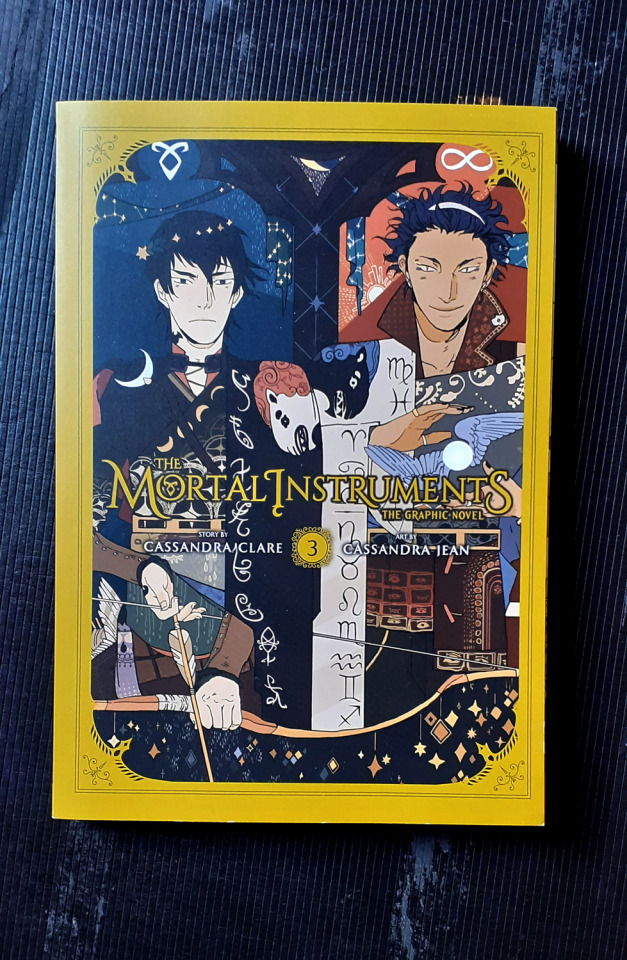

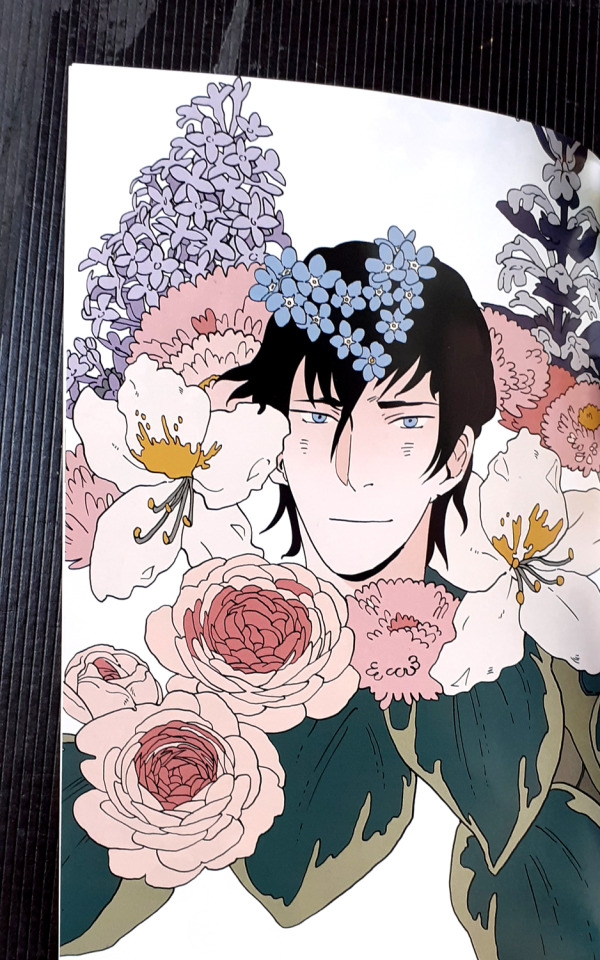
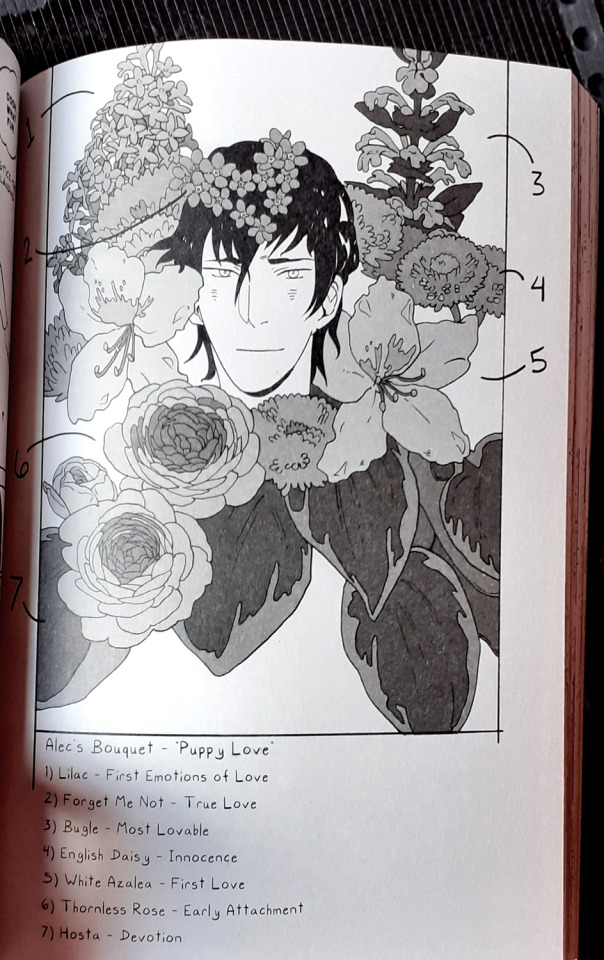
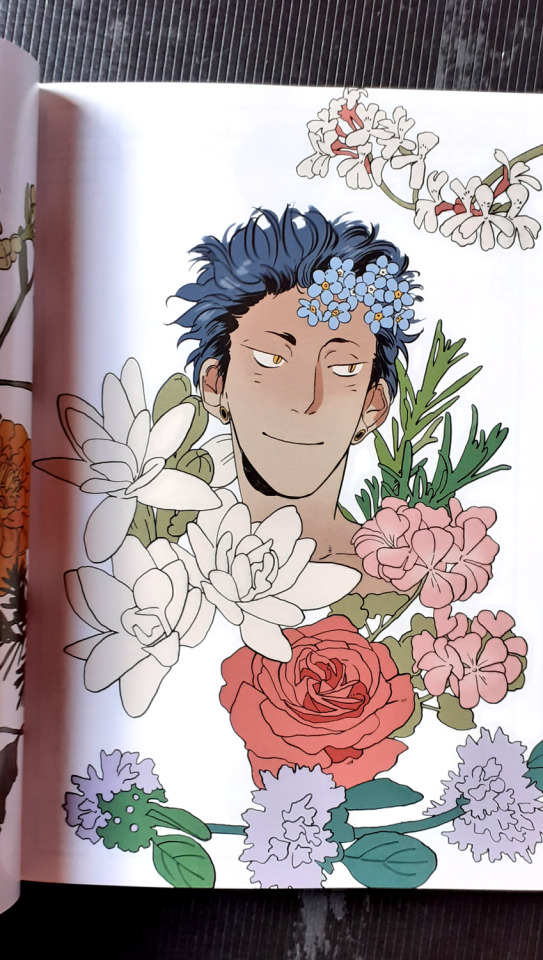



The Mortal Instruments – Graphic Novel Vol.3 Story by Cassandra Clare, Artwork by Cassandra Jean
Warning: Spoilers
With the first two volumes in this series I already knew what was going to happen based on what I’d seen from the 2013 film, volume three is the first one in which I’m reacting to (mostly) unknown story developments, and as such this is going to be a very different type of review: it will be me gushing over what I find exciting, and scowling all the disappointments.
Speaking of disappointments, when I saw this cover I got super excited that we were going to see the beginning of Alec and Magnus’ relationship, the only clips I’d seen of the tv series were relating to them and I absolutely loved it. The biggest disappointment with graphic novel volume three is that their relationship happens “off-screen”, we get hits that things have happened between them but we don’t see ANY of it first-hand. We get a casual comment from Magnus that they’ve been “friendly” with each other, and Alec getting embarrassed at a love bite on his neck, and Jace remarking that he doesn’t understand why they are keeping their relationship secret. A glance here, a glance there. And that’s it. Now it could be that in the Mortal Instrument novels the Alec/Magnus storyline does indeed happen off-screen and the graphic novels have stuck to that, while the tv series had more time to show us their development, but still, I can’t suppress how disappointed I am, I was really looking forward to seeing their romance blossom.
Simon is probably the only character in this fictional world that I truly hate, he’s the dopey-eyed best friend, secretly yet not-so-secretly in love with Clary, the type to always be insinuating things but never saying them outright, always giving longing looks but never brave enough to declare their feelings properly. In this volume he calls her his girlfriend and kisses her. When someone asks Clary about it she says that she and Simon haven’t actually discussed becoming anything more than friends.
There are parallels between Simon and Clary’s relationship and Luke and Jocelyn’s, both Simon and Luke are in platonic yet potentially romantic relationships with women who are (or have been) attracted to someone else, and that someone else is more “alpha”, more charismatic than the “secondary men”. However the reason why Luke’s character works is because he has a lot more going on aside from his relationship with Jocelyn: he has a history with Valentine, he’s a werewolf and has a clan, he’s a parental figure to Clary and a source of wisdom, and he commands respect. Simon on the other hand is a mopey teenager who plays in a band and 80% of his life seems dedicated to pinning over Clary.
While it is true that Simon is going to be turned into a vampire and that is going to bring all sorts of new conflicts and drama to his life, it doesn’t fix the fact that his base character is so MEH. I’ve seen some spoilers that suggest that he and Isabelle might become a thing, which I absolutely hate, Isabelle’s character feels much older, much more mature, and she deserves more than this wimpy kid. However I am very keen on new character Maia, she looks about the same age as Simon, she’s super cute but with a bit of sass, it’s great to have more characters of different ethnic groups, and I think the fact that she’s a werewolf and Simon is a vampire and those two groups hate each other could make a potential Maia x Simon pairing really interesting, dramatic and hot.
Another pairing that I would love is Isabelle and faerie knight, Merliorn. Her over-flirtatious nature against his stoic appearance is perfection. But again spoilers indicate that Isabelle x Simon is the end goal, I’m sorry I just don’t see it.
Other comments, I find Jace’s rebel boy pick-a-fight-with-anyone attitude quite tiresome. But I’m happy with the progress between him and Clary, I already know the spoiler regarding them so I’m not on the edge of my seat for them, but I like them as a couple, helped greatly by how Clary is so likeable in the graphic novel. I am so glad I’m reading the graphic novels instead of the original novels because I can’t imagine dedicating so much reading time to multiple will-they-won’t-they romantic couples. I am, however, loving the supernatural world, really love the introduction to the faerie court and how they get in there via the moon’s reflection on a lake, and I’m liking the introduction of more werewolf and vampire characters.
Side Note: the illustrator has created a few colour illustrations that show character floral bouquets, at first I didn’t really like these, I feel like she should have drawn the bodies because it feels a little like floating heads, however I do find it interesting to read which flowers she’s picked, what they mean in the language of flowers and how that represents the character’s personality.
Review by Book Hamster
#just finished reading#graphic novel#mortal instruments graphic novel#cassandra jean#book review#book blog#love books#love reading#what i've been reading#Great Book Covers#Yen Press#manga#Teen Drama#Teen Romance#werewolves#werewolf#demons#demon hunter#vampires#werewolves and vampires
7 notes
·
View notes
Text
cdrama rec/review: le coup de foudre
KDRAMA AND CDRAMA MASTER LIST OF REVIEWS
Series: le coup de foudre / love at first sight / i don’t like this world, i only like you Episodes: 35 w/ a special Genres: then & now, slice of life, high school to adult life, romance, reunion/getting back together, working with the ex Spoilers in the Rec: for set-up/light ones for character backgrounds If You Like, You’ll Like: the reply series, sad-looking dogs that are loved very much, because this is my first life (VERY similar male lead), sibling love, my sunshine but if people were nicer and had significantly better hair, multiple couples that are all a lot of fun
Rank: 10/10

PREMISE
flashback to 6-8 years ago (because the OP here can’t remember lol): it’s desk selection day in qiao yi’s classroom! a very dramatic moment for all high schoolers, qia yi has to select who she sits next to. because she’s at the bottom of the class ranking, she gets last pick, which essentially narrows down her choices to that creepy kid who writes love poetry to every female student in the class and yan mo, the scary genius student who has placed 1st in their class since...forever.
taking a gamble, qiao yi goes with yan mo. yan mo eventually agrees to tutoring qiao yi outside of class and they become friends. then...friends? if you know what i mean. it’s very sweet and cute. only problem is that yan mo is both a genius and from a Family of Means, and so is already planning on attending cambridge (yeah, fucking cambridge) after graduation. not wanting to separate, yan mo asks qiao yi to come with him and she agrees to study hard so she can get accepted to a university in the UK, too.
but then, well, bad shit happened.
qiao yi ended up staying in their home town, yan mo left for cambridge, and we got two v heartbroken teenagers on our hands.
4 years later, yan mo returns after studying in the uk, and by chance they end up bumping into each other. angry because qiao yi hurt him, yan mo puts up an ALOOF AND COLD AND I DONT CARE AT ALL front that she sadly buys. but after he leaves for the big city to pursue a business opportunity, qiao yi harnesses some amazing big dick energy to go after him, in a sort of inverse DONT LET HER GET ON THAT PLANE! move. very abba.
the plot bounces between their (and their friends’) high school years, their lives as reunited adults, and their future lives as married folks. i love it very, very much.
MAIN CHARACTERS
zhao qiao yi

as a high schooler, qiao yi was a quiet girl with low self-esteem, who consistently ranked at the bottom of her class and was always attempting to retreat into her school tracksuit like a turtle. despite this, qiao yi has some solid friends and is always kind if somewhat shy or uncomfortable in certain situations. as a adult, qiao yi works as a television producer and is clearly more confident.
she buys truly awful graphic t-shirts as thank you gifts that one feels obligated to wear. falls for scams easily. will help you fold 1000 paper stars for your boyfriend even if she hates your boyfriend because she’s ride or die like that. look at how cute she is no one is allowed to be mean to someone as cute as this.
yan mo / “frank”
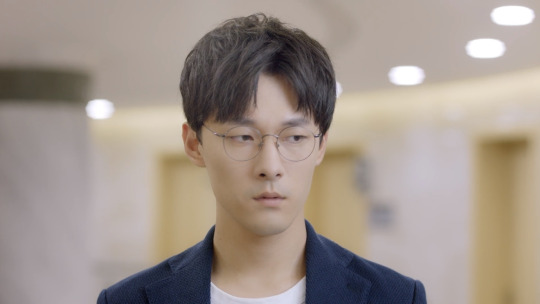
if you liked se hee in because this is my first life, you’re in luck because here is a 10% angrier version. at first, yan mo seems cold, aloof, snobbish, pretentious, arrogant...
okay, but he’s ALSO got a lot of feelings and will help people out. well, at the start of the show, he’ll help two people out. but that expands to like 10. so, progress! in high school, he falls for qiao yi in the typical Cannot Spit It Out fashion, buying her sentimental cans of coke, PUTTING IN ONE EARBUD SO SHE CAN LISTEN TO THE BEATLES WITH HIM, feeling Weird about her tying his tie, and single-handedly ruining a for-profit afterschool tutoring business in about 30 seconds, because they weren’t teaching qiao yi anything, and he knew he could do it better. tbh he completely fucking destroys a lot of things and people in under a minute. #ruthless
he’s very protective of qiao yi and rather than explain it, here is a clip from the special episode where yan mo confronts another student who left a love confession meant for qiao yi in his desk by mistake (subtitles have to be selected under settings, but it’s subbed in english):
youtube
zhao guan chao

zhao qiao yi’s twin brother, who has always placed 2nd in their classes after yan mo. despite his high grades, he comes off as a laidback teen heartthrob and has a reputation for being a flake and a playboy. BUT he’s legit a chill dude and clearly popular for a reason--he gets along with (almost) everyone. he loves his sister and is extremely protective of her, especially since she’s so shy and has low self-esteem for Reasons That Will Be Explained in the Tragic Backstory. he’s such a good brother. the best brother. also looks out for qiao yi’s best friend, wu yi. understands the value of shoes.
hao wu yi
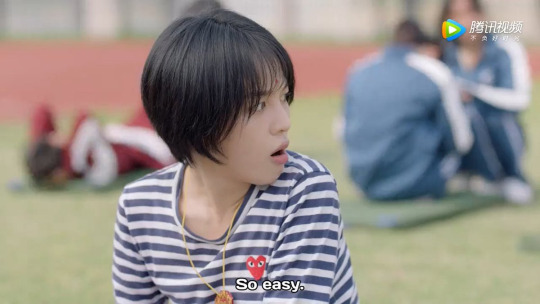
qiao yi’s best friend, and another classmate of The Crew. i say this with so, so much love, but she’s got a lot of chaotic dumbass energy. struggling along the bottom ranks with qiao yi during high school. she has the worst taste in men as a teenager, falling for the guy who literally bullied her in like. ep 2. thankfully she’s got qiao yi and guanchao.
the trio are close, and that doesn’t change as they grow up. wu yi ends up becoming a novelist who writes pop and steamy romance novels and has a significant teenage girl fanbase. it’s amazing.
fei da chuan

my boy. another classmate, he, qiao yi, and wu yi make up the official Dumbass Trio of their high school class and have adorable adventures + solidarity in it. he’s also yan mo’s uncle. somehow. because rich people families are wild. while he’s got a place to live, he more often than not crashes at yan mo’s, who Does Not Like It. but da chuan does not notice or care.
abrasive but 100% sincere about everything and toward everyone. people will think he’s an asshole or a gangster but then he’s secretly feeding abandoned kittens in the corner or something. as an adult, has the best business casual outfits. serves as a big brother figure to a lot of people, but qiao yi in particular. cannot, cannot fucking do math.
SUPPORTING
“alicia” / cheng youmei. an old family friend of yan mo’s who is very posh and rich and dignified. studied abroad with him at cambridge, and is cold toward qiao yi after arriving back in china. cosplays B)
teacher gao. everyone’s high school teacher who later owns a bar that seems to be there only for dispensing advice. seriously. there is no way this bar is economically sound as the only customers you ever see are gao’s students coming in one at a time for Wisdom and you never see them pay for anything. also the bar has no fucking roof and is directly above traintracks. i have hang-ups about this bar
lin shu. yan mo’s mother. very sweet and pretty and a ballernia turned program director. is almost never home but clearly loves her son. du chaun’s sister. somehow.
zhao suyin. qiao yi and guan chao’s mother. one of her kinks is roleplaying condor heroes characters? okay okay okay
tian weimin. qiao yi and guan chao’s stepfather who works as police officer. best dad award. he’s so sweet and corny and peak dad humor. he loves them kids & they love him back
grandpa. yan mo’s dog in high school. a very old basset hound with sad eyes:
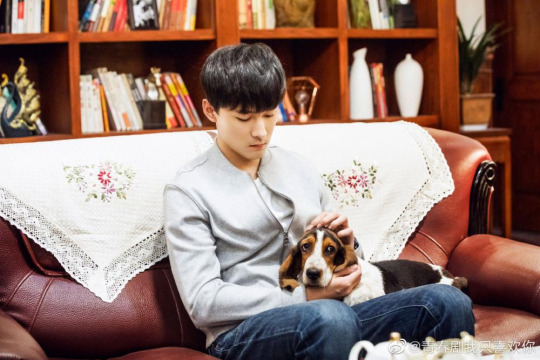
dollar or d. i cant tell you anything about him, other than he used to be a stray and yan mo says he’s ugly, which, rude.

DRAWBACKS
plot...hm. there’s SOME plot, but this is about characters + romance + friendship + family. if you’re looking for scheming mothers-in-law or tragic car accidents or secret destinies this isn’t the one for you. similar in vibe to Reply 1988 (they even watch the show in the show :’D / make references to it)
OKAY SO every plot summary i’ve seen says that yan mo is in a relationship with someone else when he gets back to china. no he is not. i say this because it was a huge turn off for me/initially put me off watching the series. he is definitely a one-and-only type. there’s no cheating in this show. lmao, hell, neither of the mains are even interested in anyone else but each other
i liked du chuan and his love interest a lot, but they definitely didn’t get as much screen time as the others
while it’s clear qiao yi + yan mo are the mains, another couple gets a lot of screen time as well. this might be a skip if you don’t like multiple couples/secondary relationships in a show
i surprisingly enjoyed the high school storyline a lot more than the adult one? which is super weird for me, but idk i was sad when it was over because it was so cute.
some...weird technical decisions. every once in a while, the camera will have like a nostalgia filter and then it disappears and then the edges get a bit blurry and idk it feels very film school 101 to show that what’s on screen is a ~memory. the soundtrack/music is sometimes also too loud--to the point where it can drown out the actors (particularly janice wu in the high school arc, since qiao yi is soft-spoken)
REASONS TO WATCH
the lead actors (janice wu + zhang yujian) are legit two of my favorites and they have great/easy chemistry. all the actors are amazing. everyone’s loveable
SIBLING GOALS the zhao twins are amazing and they’re both each other’s biggest fans. gaunchao had some really heartwarming brother moments
i love love lmao. this spoke to a lot of my favorite dynamics: exes reunited/having to work together, childhood sweethearts reuniting as adults, “gangster” and princess, childhood friends turned lovers, bickering couples, cold man who actually has a lot of feelings, lots of people being overprotective, idk. everything was just great. 0 complaints on any of the ships.
i genuinely liked every character other than that one piece of shit poppa zhao. even alicia, who’s put into the stereotypical rich bitch role, was actually really fun and subverted a lot of expectations for this trope
it’s just. real cute y’all. probably my favorite cdrama and definitely in my top 10 (maybe 5?) dramas overall.
FINAL THOUGHTS
i love them ;;

#le coup de foudre#janice wu#zhang yujian#eden zhao#ma li#cdrama#gizka does kdrama#!my post#why yes i am procrastinating please have another in this trying time#this one's my favoriiiiiiiiiiiiiiite
61 notes
·
View notes
Text
The Essential Dykes to Watch Out For, Alison Bechdel

Rating: Great Read Genre: Graphic Novel Representation: -Lesbian ensemble cast -Racially diverse ensemble cast Trigger warnings: Reclaimed D-slur, animal death, cheating, divorce, cancer, casual transphobia, biphobia, and ableism, difficult topics ranging from war to AIDS to 9/11. Note: Not YA; sexually explicit
If you’re familiar with Fun Home or Are You My Mother? you’ll know what I mean when I say that Dykes to Watch Out For is no entry level work - though Dykes to Watch Out For is difficult for different reasons. While Bechdel’s ruminations on her childhood, psyche, and sexuality require a decent amount of outside reading to be fully appreciated, Dykes to Watch Out For requires an equally rigorous knowledge of the political landscape of the past forty years.
But on the other hand, the more things change, the more they stay the same. The wars, elections, discourse, and protests are not so unfamiliar. If I had to pinpoint Dykes to Watch Out For’s continued importance to lesbians today in just one idea, it would be this: “Against the sweeping backdrop of history... everyday life pretty much continues” (371).

It’s not a major theme of the work, yet it is the shape of the final tapestry. Politics, discourse, trauma, and sickness make their ravages, and here we all are, much the same as we ever were 10, 20, 30 years ago: this pattern, far from intentional, emerges from the tide-like flow of 30 years of comics. But it’s why Dykes to Watch Out For is so special. And we have the privilege of going back to look into that reflection of the 80s, 90s, and 00s and recognize familiar features. The political scenery may be different (or, honestly, not so different) but has daily life changed much?

I first tried to read Dykes to Watch Out For as a curious high schooler, and my eyes glazed over. Without having absorbed enough recent history through cultural osmosis, nor having developed a taste for gray morality, I just didn’t get it. Two characters would have an argument on the page, both of them would make provocative points, and then Bechdel would refrain from telling her reader which was in the wrong. Neither character was a straw man; it almost felt like Bechdel was arguing with herself, trying to decide what was right - if there even was a right answer. I couldn’t wrap my mind around it, especially when the vocabulary and context were both tantalizingly out of reach.
Reading now, I found the once alien discourse all too familiar. The same exact discussions were being had in 1985 as are being hashed out on Twitter. One of a hundred examples is whether gay marriage is a buy-in to the privilege bestowed by heteronormativity. Bechdel asks if marriage is a patriarchal model that can be salvaged, but she doesn’t have an answer for you, just a prompt to chew on.
Another example is Bechdel’s discourse on the outliers of lesbian spheres: trans lesbians, trans men, genderqueer people, and bisexual lesbians (Would you believe that term is used in the text - and equally as contentiously?). These are conversations we are all very familiar with. However, this discourse is especially interesting in a work that took 30 years to write. The reader combs through 30 years of metamorphosis in just a handful of hours. Bechdel’s tongue-in-cheek “Whatever will they come up with next?” is printed in the same volume with genuine consternation on who is allowed to be a lesbian.
Trans women start as a punchline. But on most topics, Dykes to Watch Out For tends, eventually, to stop itself to re-evaluate. Thirty years later, one of the main characters IDs as genderqueer, finds herself meeting trans men and doing drag king shows, fights with her friends over their trans exclusivity, and in the end, ends up advocating for and co-parenting a teenage trans girl, who ends up a main character in her own right. It’s one of Bechdel’s firmer positions on right and wrong, although she doesn’t hesitate to mouth the opposite argument, too.
Plenty of sympathetic characters say transphobic things which just hang in the air, unaddressed. It’s maddening - but in sticking with the material, I got to see the characters who flubbed the pronouns and complained about gender confusion eventually get in line - changes which are not commented upon and happen so gradually in the thirty years over which the comic was written, that they mimic how change happens in real life. In our own lives, change may seem impossible, but then you blink, a decade has passed since you first came out, and half the homophobes have come around. Much the same for Dykes to Watch Out For, which is almost as much a memoir as Fun Home (albeit of Bechdel’s discourse rather than her life). I think every cisgender lesbian should read it - it’s a powerful antidote against TERFism, not because it lays down the law, but because it meets you where you are and gives you the chance to say your piece without ridicule, before taking you by the hand and showing you something kinder. If Dykes to Watch Out For has anything to teach us, it’s that hard lines in the sand make you look like a dick thirty years later. Take Sparrow’s story arc. Mo, Lois, and Ginger are thrown when their friend Sparrow starts dating a man. They say some rotten things about how betrayed they are, how they don’t know if they can trust Sparrow anymore, or her politics - but when they are overheard, the “discourse” suddenly becomes real. That’s their friend, and her feelings are hurt. What else can you do for your friend who has spent decades of her life as a lesbian, whose identity is culturally and socially interwoven with lesbianism, and who identifies as a bisexual lesbian - except love her?
A frequent lesson is that anyone can be reactionary - even the left-est of leftists. Years later, when Sparrow faces an accidental pregnancy, her friends overwhelmingly pressure her to keep the baby, not because of their politics, but because of their excitement - yet the impact, if not the intent, is anti-choice. It’s ideas like these being brought to the forefront that make Dykes to Watch Out For something special.
In her introduction to the book, Bechdel frets over both keeping up with the changing current of discourse (XVI)

...and her own role in shaping that discourse (XVII)

But her work speaks for itself: if we are to do right by one another, we must prioritize one another, not the rules. The same conversations will be had again, and again, and again, from 1983 until we all go blue in the face. We can’t control someone angrily shouting into the room (or Twitter timeline) “but WHAT about BISEXUAL LESBIANS?” and the chaos that follows - but we can accept that someone will shout it again in twenty years, and that the following chaos will be so nearly identical to the previous chaos as to challenge whether it is chaos at all, or just the universe putting on a matinee performance of the same old song and dance. Is it useful to put on your tap shoes and sing along? Or do you end up hurting the feelings of a genuine friend who just happens to be one of the outliers this time around?
Dykes to Watch Out For is thought-provoking (as you can see, my thoughts have been well and truly provoked), occasionally in poor taste, but mostly surprisingly sympathetic, both to its more marginalized characters, and to its wrong-doers - this comic doesn’t have any villains. The initial gag, that Bechdel would write a catalog of lesbians like a lepidopterist giving clinical attention to a series of specimens, works to her favor. There are no bad lesbians and good lesbians. At least, not essentially. This approach lends Dykes to Watch Out For more staying power than it might otherwise have had - it’s relatable. You know these people. You’ve had some of these arguments, and hurt each other’s feelings over them. Your friends live in the mildewy house that’s kept at 64 degrees in the winter, where you’re as likely to be walked in on in the bathroom as not, a home where everyone in the friend group feels free to stop by.
Here in the future, we have the immense privilege of watching how these parallel lives to ours play out. The Essential Dykes to Watch Out For may be a comic for a different generation, but Bechdel has given us something fascinating from both a history and literary perspective. She has put to paper a sprawling epic about lesbians growing from their twenties to their forties, getting married (or not), progressing their careers, having children, having PTA meetings, having affairs, and doing civil disobedience with their kids. Rarely do we see the map from here to there laid out so meticulously. I read this book voraciously, both the earlier chapters that relate to life as a new adult, and the later chapters, which serve as a window into what life was, and could be.
For more from Alison Bechdel, visit her Twitter here.
#the essential dykes to watch out for#alison bechdel#lesbian#great read#graphic novel#protagonist of color#not ya#reviews only
90 notes
·
View notes
Text
My (Updated) Masterpost for Asexuality [2020]:
Some Youtube Videos I found Really Lovely and Validating:
Debunking Asexual and Aromantic Myths
Ace-Spec and Are-Spectrum Book Recommendations
And Some LGBTQIA+ Channels That Bring Up Asexual Experiences:
Rowan Ellis
Problems of a Book Nerd
Jessica Kellgren-Fozard
Some Shows with Confirmed Asexual Characters:
Sex Education
Bojack Horseman
Liv in ‘Emmerdale’ (UK Soap)
Historical Asexuals/ Demisexuals:
Emily Brontë: Emily Brontë was a very private person and as such it’s impossible to be entirely certain of her sexual orientation. Some Brontë scholars believe she died a virgin, never having had physical relationships with men or women. However, most Brontë scholars think that the content of her novels would suggest she may have been asexual, but she was not aromantic.
J.M. Barrie: The man who wrote Peter Pan into existence, was reportedly asexual. His marriage was never consummated and ended in divorce when his wife cheated on him. Because of his relationship with his neighbor children, and the subject matter of his books, some speculated Barrie was prone to pedophilia. Those who knew him closely vehemently deny Barrie ever exhibited such behavior. Instead his lack of sexual relationships was more likely due to his asexuality.
George Bernard Shaw: Renowned playwright George Bernard Shaw was a man far more interested in intellect than sex. He never consummated his marriage (also at the request of his wife, Charlotte Frances Payne-Townshend) and was a virgin until 29. Shaw told friends he appreciated the ability of sex to produce “a celestial flood of emotion and exaltation” but only as it compared to the “conscious intellectual activity” he strove for with his work.
Isaac Newton: Isaac Newton’s supposed asexuality is based on his recorded behavior and lifestyle. He had strict religious views, never married, was obsessive in his scientific careers, and supposedly died a virgin. Whether he truly lacked sexual attraction or was simply too immersed in making massive scientific discoveries to have a sex life is unsure.
T.E. Lawrence: Tragically, T.E. Lawrence – a man immortalized in the film Lawrence of Arabia – was sexually assaulted while held prisoner during The Great War. His lack of sexual and romantic relationships in life were mostly attributed to this trauma but some scholars argue he may have been asexual. He had no documented relationships with men or women. Most notably, since it was the turn of the 20th century, Lawrence was known to be non-judgmental of homosexuals. His personal orientation may have motivated his tolerance.
Florence Nightingale: Interestingly, though “the Florence Nightingale effect” is a situation where a caregiver develops an attraction to the patient they are caring for, the effect’s namesake, Florence Nightingale, was likely asexual. The famous nurse never married and instead chose to devote her life entirely to her work. She even refused a marriage proposal from a suitor who had been pursuing her for years. Nightingale rarely discussed her personal life and the term “asexual” was not widely used at the time, but asexual activists and scholars strongly suspect she lacked sexual interest.
Nikola Tesla: Nikola Tesla, the revolutionary engineer who was instrumental in the invention of electricity, also lived a life of celibacy typical of asexuals. He showed very little interest in sexual relationships throughout his life, preferring to focus on science. Many asexuals describe their lack of attraction as a blessing allowing them sharp focus. Once again, we have a person who could have been too busy (and brilliant) to focus on relationships, but who’s asexuality likely allowed him to be busy (and brilliant). [Fun fact: I am actually related to ol’Nikola. Sometimes it’s nice to even think about someone in my family being asexual, because it makes me feel like we’d both be able to get along together when we get fixed in our little studies, research, and schemes ♥]
Frederic Chopin: Famed composer and pianist Frederic Chopin is supposed to also have been asexual. While he lived with writer George Sand, she noted in her biography that their connection was affectionate without being sexual. She described their affair as “eight years of maternal devotion,“ also noting, “He seemed to despise the courser side of human nature and…to fear to soil our love by further ecstasy.��Whether Chopin was uninterested in sex, or had reservations about consummating the relationship for other reasons, is unclear. Many scholars believe the famed pianist lacked sexual desire altogether.
John Ruskin: Victorian art critic John Ruskin was known to be particularly uninterested in sex. Though Ruskin was once married, he reportedly showed no interest in getting physical with his wife. Typical of other asexuals on this list, his marriage ended having never been consummated.
Young Adult Fiction/ Books about Asexuality (NOTE: Some of these are coming out later this year, August and September 2020):
How to be Ace: A Memoir of Growing Up Asexual by Rebecca Burgess: Brave, witty and empowering, this graphic memoir follows Rebecca as she navigates her asexual identity and mental health in a world obsessed with sex. From school to work to relationships, this book offers an unparalleled insight into asexuality.
Ace: What Asexuality Reveals About Desire, Society, And The Meaning Of Sex by Angela Chen: An engaging exploration of what it means to be asexual in a world that’s obsessed with sexual attraction, and what the ace perspective can teach all of us about desire and identity. What exactly is sexual attraction and what is it like to go through life not experiencing it? What does asexuality reveal about gender roles, about romance and consent, and the pressures of society? This accessible examination of asexuality shows that the issues that aces face–confusion around sexual activity, the intersection of sexuality and identity, navigating different needs in relationships–are the same conflicts that nearly all of us will experience. Through a blend of reporting, cultural criticism, and memoir, the misconceptions around the “A” of LGBTQIA and invites everyone to rethink pleasure and intimacy.Journalist Angela Chen creates her path to understanding her own asexuality with the perspectives of a diverse group of asexual people. Vulnerable and honest, these stories include a woman who had blood tests done because she was convinced that “not wanting sex” was a sign of serious illness, and a man who grew up in a religious household and did everything “right,” only to realize after marriage that his experience of sexuality had never been the same as that of others. Disabled aces, aces of color, gender-nonconforming aces, and aces who both do and don’t want romantic relationships all share their experiences navigating a society in which a lack of sexual attraction is considered abnormal. Chen’s careful cultural analysis explores how societal norms limit understanding of sex and relationships and celebrates the breadth of sexuality and queerness.
Let’s Talk About Love by Claire Kann: Alice’s last girlfriend, Margo, ended things when Alice confessed she’s asexual. Now Alice is sure she’s done with dating… and then she meets Takumi. She can’t stop thinking about him or the rom-com-grade romance feelings she did not ask for. When her blissful summer takes an unexpected turn and Takumi becomes her knight with a shiny library-employee badge, Alice has to decide if she’s willing to risk their friendship for a love that might not be reciprocated– or understood. [A bisexual POC protagonist; adorable fluffy, easy and sweet read].
All Out: The No-longer-secret Stories of Queer Teens Throughout the Ages: Take a journey through time and genres and discover a past where queer figures live, love, and shape the world around them. Seventeen of the best young adult authors across the queer spectrum have come together to create a collection of beautifully written diverse historical fiction for teens. [This features several different types of queer stories, from transexual freedom fighters, but also a very sweet asexual love story set in a seventies roller rink with a POC protagonist].
The Pride Guide: A Guide to Sexual and Social Health for LGBTQ Youth by Jo Lanford: Jo Langford offers a complete guide to sexual and social development, safety, and health for LGBTQ youth and those who love and support them. Written from a practical perspective, the author explores the realities of teen sexuality, particularly that of trans teens, and provides guidance and understanding for parents and kids alike. [Although this is a little rudimentary, I found it a great resource even in my twenties for someone coming out, or to slowly but carefully come out to those who may be uncomfortable or not understand asexuality, or not see it as a valid sexuality or lack thereof].
Tash Hearts Tolstoy by Katie Ormsbee: Natasha ‘Tash’ Zelenka has found herself and her amateur web series plucked from obscurity and thrust in the limelight. And who wouldn’t want fame and fortune? But along with the 40,000 new subscribers, the gushing tweets, and flashing Tumblr gifs, comes the pressure to deliver the best web series ever. As Tash struggles to combat the critics and her own doubts, she finds herself butting heads with her family and friends - the ones that helped make her show, Unhappy Families (a modern adaption of Anna Karenina, written by Tash’s eternal love Leo Tolstoy), what it is today. And when Unhappy Families is nominated for a prestigious award, Tash’s confusing cyber-flirtation with an Internet celeb suddenly has the potential to become something IRL if she can figure out how to tell him that she’s a romantic asexual. But her new relationship creates tension with her friend Paul since he thought Tash wasn’t interested in relationships ever. All Tash wants to think about is the upcoming award ceremony in Orlando, even though she’ll have to face all the friends she steamrolled to get there. But isn’t that just the price you pay for success?
Every Heart a Doorway by Seanan McGuire: The story is set in a boarding school for teenagers who have passed through "doorways” into fantasy worlds only to be evicted back into the real world. It serves as something of a recovery center for boarders who find they no longer fit in, either in the “real” world or their own uncomprehending families. For a fortunate few it is just a way station until they can find their ways back to the worlds they do fit into; for others, it’s the least bleak choice in what may be a life-long exile. This unhappy ending for the students takes a terrifying turn when some of their number start turning up dead. A small group joins together in an attempt to expose the person committing these murders before it is too late to save the school, or even themselves.
The Invisible Orientation: An Introduction to Asexuality by Julie Sondra Decker: What if you weren’t sexually attracted to anyone?A growing number of people are identifying as asexual. They aren’t sexually attracted to anyone, and they consider it a sexual orientation—like gay, straight, or bisexual.Asexuality is the invisible orientation. Most people believe that “everyone” wants sex, that “everyone” understands what it means to be attracted to other people, and that “everyone” wants to date and mate. But that’s where asexual people are left out—they don’t find other people sexually attractive, and if and when they say so, they are very rarely treated as though that’s okay.When an asexual person comes out, alarming reactions regularly follow; loved ones fear that an asexual person is sick, or psychologically warped, or suffering from abuse. Critics confront asexual people with accusations of following a fad, hiding homosexuality, or making excuses for romantic failures. And all of this contributes to a discouraging master narrative: there is no such thing as “asexual.” Being an asexual person is a lie or an illness, and it needs to be fixed.In The Invisible Orientation, Julie Sondra Decker outlines what asexuality is, counters misconceptions, provides resources, and puts asexual people’s experiences in context as they move through a very sexualized world. It includes information for asexual people to help understand their orientation and what it means for their relationships, as well as tips and facts for those who want to understand their asexual friends and loved ones [A good beginning place to start if you’re considering your asexuality. Also provides reassurances about the most common stereotypes concerning asexuality].
Switchback by Danika Stone: Vale loves to hike, but kind of hates her classmates. Ash is okay with his classmates, but kind of hates the outdoors. So, needless to say they are both fairly certain that the overnight nature hike with their PE class is going to be a hellish experience. But when they get separated from the group during a storm, they have worse things to worry about than bullies and blisters.Lost in the Canadian wilderness with limited supplies, caught in dangerous weather conditions, and surrounded by deadly wildlife, it’s going to take every bit of strength, skill, and luck they can muster to survive.
Not Your Backup (Sidekick Squad #3) by C.B. Lee: Emma Robledo has a few more responsibilities that the usual high school senior, but then again, she and her friends have left school to lead a fractured Resistance movement against a corrupt Heroes League of Heroes. Emma is the only member of a supercharged team without powers, and she isn’t always taken seriously. A natural leader, Emma is determined to win this battle, and when that’s done, get back to school. As the Resistance moves to challenge the League, Emma realizes where her place is in this fight: at the front. [This is a third in a series, but the main character has recently come out as asexual at the end of the last book].
If It Makes You Happy by Claire Kann: Winnie is living her best fat girl life and is on her way to her favorite place—Misty Haven and her granny’s diner, Goldeen’s. With her family and ungirlfriend at her side, she has everything she needs for one last perfect summer before starting college in the fall.…until she becomes Misty Haven’s Summer Queen.Newly crowned, Winnie is forced to take center stage at a never-ending list of community royal engagements. Almost immediately, she discovers that she’s deathly afraid of it all: the spotlight, the obligations, and the way her Summer King wears his heart, humor, and honesty on his sleeve.To salvage her summer Winnie must conquer her fears, defy expectations, and be the best Winnie she knows she can be—regardless of what anyone else thinks of her. [Another POC protagonist and promises to be a cute summer read in the vein of Gilmore Girls. Claire Kann’s first book was the adorable ‘Lets Talk About Love’ which reads as an asexual rom-com. This also promises to be absolutely precious.].
Immoral Code by Lillian Clark: Ocean’s 8 meets The Breakfast Club in this fast-paced, multi-perspective story about five teens determined to hack into one billionaire absentee father’s company to steal tuition money.For Nari, aka Narioka Diane, aka hacker digital alter ego “d0l0s,” it’s college and then a career at “one of the big ones,” like Google or Apple. Keagan, her sweet, sensitive boyfriend, is happy to follow her wherever she may lead. Reese is an ace/aro visual artist with plans to travel the world. Santiago is off to Stanford on a diving scholarship, with very real Olympic hopes. And Bellamy? Physics genius Bellamy is admitted to MIT–but the student loan she’d been counting on is denied when it turns out her estranged father–one Robert Foster–is loaded. Nari isn’t about to let her friend’s dreams be squashed by a deadbeat billionaire, so she hatches a plan to steal just enough from Foster to allow Bellamy to achieve her goals.
Loveless by Alice Oseman: The fourth novel from the phenomenally talented Alice Oseman - one of the most authentic and talked-about voices in contemporary YA.It was all sinking in. I'd never had a crush on anyone. No boys, no girls, not a single person I had ever met. What did that mean? Georgia has never been in love, never kissed anyone, never even had a crush - but as a fanfic-obsessed romantic she's sure she'll find her person one day. As she starts university with her best friends, Pip and Jason, in a whole new town far from home, Georgia's ready to find romance, and with her outgoing roommate on her side and a place in the Shakespeare Society, her 'teenage dream' is in sight. But when her romance plan wreaks havoc amongst her friends, Georgia ends up in her own comedy of errors, and she starts to question why love seems so easy for other people but not for her. With new terms thrown at her - asexual, aromantic - Georgia is more uncertain about her feelings than ever. Is she destined to remain loveless? Or has she been looking for the wrong thing all along? This wise, warm and witty story of identity and self-acceptance sees Alice Oseman on towering form as Georgia and her friends discover that true love isn't limited to romance.
The Last Eight by Laura Pohl: Extinction was just the beginning in this thrilling, post-apocalyptic debut, perfect for fans of The 5th Wave series. Clover Martinez has always been a survivor, which is the reason she isn’t among the dead when aliens invade and destroy Earth as she knows it.Clover is convinced she’s the only one left until she hears a voice on the radio urging her to go to the former Area 51. When she arrives, she’s greeted by a band of misfits who call themselves The Last Teenagers on Earth.Only they aren’t the ragtag group of heroes Clover was expecting. The seven strangers seem more interested in pretending the world didn’t end than fighting back, and Clover starts to wonder if she was better off alone. But when she finds a hidden spaceship within the walls of the compound, she doesn’t know what to believe…or who to trust. [I’ve read there is also aromantic representation in this book too, so helpful for the Aros out there as well ♥]
LGBTQIA+ Comics with Possible Asexual Representation/ Influence:
Lumberjanes: At Miss Qiunzella Thiskwin Penniquiqul Thistle Crumpet’s Camp for Hardcore Lady Types, things are not what they seem. Three-eyed foxes. Secret caves. Anagrams. Luckily, Jo, April, Mal, Molly, and Ripley are five rad, butt-kicking best pals determined to have an awesome summer together…and they’re not gonna let a magical quest or an array of supernatural critters get in their way! [I LOVE THESE COMICS SO MUCH I SWEAR THEY’RE SO DAMN CUTE ♥]
The Backstagers: When Jory transfers to the private, all-boys school St. Genesius, he figures joining the stage crew would involve a lot of just fetching props and getting splinters. To his pleasant surprise, he discovers there’s a door backstage that leads to different worlds, and all of the stagehands know about it!All the world’s a stage…but what happens behind the curtain is pure magic!
And Lastly, Extra Online Resources For Asexuality:
UCLA LGBT Campus Resource Center: Asexuality
The Trevor Project on Asexuality
Campus Pride: Asexuality
The Canadian Centre for Gender Diversity and Awareness
Asexuality needs to be a recognized as its own, unique sexual orientation, Canadian experts say
Asexuality.org
A Lot of Ace (An Ace Positivity Blog on Tumblr ♥)
#asexuality#masterpost#lgbt+#lgbtqia+#queer masterpost#queer rights#queer history#queer literature#you're welcome#but honestly I love everything on here besides the shows which I actually haven't seen outright#but it's good to know those are out there#also I need to read the newest books of lumberjanes and backstagers#because they're adorable#personal#a-lot-of-ace
10 notes
·
View notes
Text
tagged by: @hartigays and @myboyfriendsteve thank you bbs<333
rules: pick 5 shows, then answer the following questions! don’t look at them, and don’t cheat. then tag some people.
breaking bad
stranger things
game of thrones
daredevil
watchmen
who is your favorite character in 2? Hopper -- I have so much affection for him lol
who is your least favorite character in 1? Marie -- skylar’s sister. God she irritated the living fuck outta me.
what is your favorite episode of 4? s1 e2 Cut Man: the fight choreography in the hallway fight scene is just beautifully done in 1 shot and feels like a gritty fight would feel -- fucking exhausting lol. I love it just for that scene alone.
what is your favorite season of 5? Watchmen, unfortunately, only has 1 season and looks like it’ll only have 1 season.
who is your favorite couple in 3? Daenerys/Drogo. God. I feel swoony thinking of them again.
what is your favorite episode of 1? s5 e14, Ozymandias. It felt epic. Truly a breathtaking episode. Beautifully directed and beautifully acted -- will never forget Hank’s death and Walt calling Skylar to set himself up to take all the blame.
what is your favorite episode of 5? episode 6 -- This Extraordinary Being, where we get Hooded Justice’s origin story and it’s a tought-provoking commentary on racism too.
what is your favorite season of 2? ST is such a fantastic show but I really love s3. It was a great mix of comedy, horror, 80s secret Russian plot substory, scifi, and drama. Well done.
how long have you watched 1? It only had 5 seasons so -- I watched all 5 as they were running, lol, and have rewatched it all at least once.
how did you become interested in 3? The bf was watching it and I got hooked. I ended up reading the books ahead of the series and knew what was gonna happen ahead of the red wedding, lol. What a run with that show.
who is your favorite actor in 4? Charlie Cox, ofc! he carried the whole show
which do you prefer- 1, 2, or 5? THAT’S A HARD ONE. between breaking bad, ST, and watchmen? GOD how dare you make me make this choice! I like them all for diff reasons. I guess, overall, breaking bad has more seasons than watchmen, as well ast ST, and is so well-writtten, acted, directed, etc. Breaking Bad it is, then.
which show have you seen more episodes of- 1 or 3? I’ve seen all of breaking bad AND got lol -- I guess there are technically more episodes of GoT so -- GoT?
If you could be anyone from 4, who would you be? LOL oh god being on daredevil would be DANGEROUS. I guess -- maybe Marci? Badass sexy lawyer who gets to have a cute relationship with Foggy, lol.
would a crossover between 3 and 4 work? game of thrones/daredevil? LMAO hardly would westeros and hell’s kitchen cross paths! nice try though
pair two characters in 1 who would make an unlikely but strangely okay couple: Hm -- Walter White and Gale, the other meth maker who was killed? Gale seems like a gentle enough soul and might do well with Walter’s intellect? I mean they both clearly have questionable morals but are still intellectual, smart, and well-spoken lol
overall, which show has the best storyline: 3 or 5? Watchmen. Watchmen was just beautifully written, no two ways about it. Really put me in mind of Alan Moore’s beautfilly written graphic novel of it.
which has better theme music: 2 or 4? betw ST and daredevil, LMAO hands down stranger things. I’m a HUGE sucker for 80s nostalgia -- including music.
Hm, I’ll tag: @introvertia @flippyspoon @grabmyboner @wrecked-fuse @gideongrace
8 notes
·
View notes
Text

The Looking Glass Wars by Frank Beddor
"'It's all in your head,' Genevieve said. 'I know,' said Alyss, and despite the traumas of the past, the uncertainty of the future, she wouldn't have given up this moment for anything. 'Isn't it wonderful?'"
Year Read: before 2013, 2020
Rating: 3/5
About: Alyss Heart, princess of Wonderland, has fled to Victorian London to escape the tyranny of her Aunt Redd. Trapped in a world where no one believes her stories and her imagination is slowly leaving her, she's forced to become someone else to survive with her adopted family. As years pass, even Alyss believes that it was all just stories she made up. Meanwhile, Hatter Madigan is failing to fulfill his promise to the former queen that he'll look after Alyss as he scours the human world for the lost princess. Wonderland won't leave her alone forever, and Redd won't settle for anything less than blood. Trigger warnings: death, parent death, violence, injury, blood, some body horror, fat shaming, grief.
Thoughts: I read this years ago and never got around to finishing the trilogy, and I like it better on a second pass. In part, I think it's that I was better able to grasp some of the world-building on a second read, and also that I've read much worse Alice in Wonderland adaptations since then. There's no denying that Beddor's Wonderland is strange, as all Wonderlands tend to be, but it's not as complicated as I first thought. It's a weird blend of fantasy, science fiction, and something almost like steampunk (Hatter's weapons, in particular). If there's something I didn't like about it, it's that the magic is based primarily on whatever characters can imagine, and imagination has no limits. There are a lot of odd inventions, and there were moments when I wanted the narrative to slow down and explain some of them a little more. (I thought Glass Eyes were literally giant floating eyeballs on my first read. Spoiler alert: They're not.)
It's a surprisingly fast-paced read despite the fact that it spans roughly thirteen years in one novel. Beddor keeps the action sequences coming, and there were times it felt like he was pulling influence from graphic novels. Given that Hatter's story continues in a graphic novel series, that's not surprising. The whole novel might benefit from artwork that picks up where some of the fleeting descriptions don't quite take off. My edition has a handful of truly lovely illustrations in it, and they really helped me with what a card soldier is supposed to look like. (My mind automatically pictured the Disney version. Beddor's are scarier.)
Alyss took a while to grow on me, but that's understandable. At first, she's a spoiled child with a child's limited worldview, and then she's tossed into a world where no one believes a word she says. Her strength is quiet, but it develops consistently over the course of the book; I'll be interested to see what she's like in the next one, after everything that's happened. The rest of the Alice characters are hit or miss, Hatter being the most notable as the stoic assassin and protector. (I do love assassin characters, and Mad Hatters.) Alice also has her own brooding love interest in Dodge, and I'm excited to see more of Molly later on. The villains aren't quite as strong. It's hard to write a Red Queen who isn't irritatingly over the top (unless you’re Marissa Meyer), and both she and the Cat feel rather flat compared to the others. I didn't enjoy all the fat-shaming descriptions of Jack of Diamonds either; those kinds of jokes didn't age well in almost fifteen years. All things considered though, it's a solid start to the series, and I'm looking forward to the rest.
#book review#the looking glass wars#frank beddor#fairytalefebruary2020#alice in wonderland#fairytale retelling#ya fantasy#3/5#rating: 3/5#2020
16 notes
·
View notes
Text
Book Recs for Magnus Archives Fans
I was just rambling in tags the other day about how my avatarsona was "the Archivist, but a public librarian: Oh, you like dirt?? Let me tell you all the dirt stories I have!!!!" so, uh, here I am I guess.
I'm gonna spare you all the M.R. James and Algernon Blackwood and House of Leaves and Blindsight; you know all that already. These are my horror backlist recs.
The Bone Key by Sarah Monette Y'all. Y'ALL. Kyle Murchison Booth was absolutely the Archivist before Gertrude. He was poached from the Parrington by the Usher Foundation and the Eye glommed onto him at once, because the Eye loves disaster queers who can't people right (and also Gertrude). This I believe to be true, and so will you.
Kyle Murchison Booth is an archivist at the Parrington Museum, which is somewhere in New England, sometime in the early twentieth century. He also has a lifelong entanglement with the supernatural which is almost entirely not his fault, and he would very much like it to stop, but he also feels responsible and he can't just let evil mirrors and cursed necklaces and possessed dressing gowns randomly eat people who have no idea what's happening. Even if it means he's going to suffer for it.
(This collection doesn't contain all of the Booth stories, so here I am going to link to "White Charles", which happens to be my very favorite Booth story.)
For you if your favorite part is: honestly everything about MAG, from the modern sensibilities about early twentieth-century-horror, truly eerie ghost stories, to suffering eldritch librarians (thanks to whoever tagged my most recent fic with that you're so valid), monsterfucking and soft gay pining. No happy endings here, sorry.
Bedfellow by Jeremy C. Shipp You may or may not have heard that Macmillan-Tor is launching a horror imprint, and I don't know how long it's been since a major publishing house has had a horror imprint, but I am EXCITE. This book is part of the trend that's the reason why: Tor.com has been publishing these kickass novellas for a couple years now, and their horror books are top notch.
One night a stranger knocks on a family's living room window and asks to be invited in. They ask him to stay the night. He's an old friend, after all, he needs a place to stay. You can't kick out your twin brother when he's just gotten divorced, no matter how much Gatorade he spills on your two-year-old hardwood floors.
For you if your favorite part is: the Stranger, this is all Stranger, it's terrifying and good.
Through the Woods by Emily Carroll A graphic novel, some of these were originally posted as webcomics (have you seen His Face All Red, and if not, why not???) and the only disadvantage to having them in book form is they can't blink at you. Probably. Very folktale-ish, with all the death and violence that implies, and also the slightly eerie feeling that you know this story already, and then it turns around and slaps you.
For you if your favorite part is: looking over your shoulder when the foley gets good; Once Upon a Time in Space (I know that's not technically part of the Magnus Archives but shush)
Universal Harvester by John Darnielle I am not usually a fan of artists who jump media. Just because you can write songs doesn't mean you can write novels. Apparently writing good songs doesn't mean you can't write good novels, though, because John Darnielle of The Mountain Goats (pretty sure that's his full name at this point) wrote Universal Harvester and I love him for it.
Jeremy works at a video rental place in Nevada, Iowa (it's pronounced Nah-vey-da, and yes it’s real, I've been there, and yes, it's probably haunted). It's the 1990s, and someone's been returning their VHS tapes with something on them that isn't just the movie. Footage that includes a barn that he recognizes, just outside of town.
Fair warning: this is not the kind of mystery that gets tied up in a nice bow at the end.
For you if your favorite part is: Jon losing it with paranoia in S2, The People's Church of the Divine Host, the Lonely
The Good House by Tananarive Due If this author's name is unfamiliar to you, RUN, do not walk, to your nearest internet bookseller and purchase every single one of her books immediately, you will not regret it. She also just came out with a documentary on black horror, Horror Noire, on the Shudder streaming service. They've got a free month if you aren't a horror movie person, it'd be worth your while. This book summary sounds like it's full of tropes. It is, but Due has the cred to write them well.
Angela Toussaint hopes to salvage her suffering marriage and her troubled relationship with her teenage son with a trip to her grandmother's house, a home so beloved the locals in small-town Washington state call it "The Good House," but tragedy strikes instead. Two years later she returns and finds that the tragedy isn't over, and it's not going to stop on its own.
For you if your favorite part is: the very practical statement-givers who know what's happening to them and Will Not Put Up With This Shit, the Desolation, the Hill Top Road statements
The Library at Mount Char by Scott Hawkins Is this horror disguised as fantasy? Found family disguised as horror? Grown-up Neil Gaiman? Less grimdark George R.R. Martin? Honestly I have no fucking idea, but it's amazing. Fair warning, unlike Magnus Archives, this deserves all kinds of trigger warnings, including but not necessarily limited to: sexual assault, torture, mental manipulation, dysfunctional families, incest(?)
Father is missing, and his twelve children (though extremely talented in their own ways, and not strictly speaking children any more) are at a loss without him. But also, without him, things are starting to seem different. He might be God? They might not be human? (They were probably human once.) He might not be God but maybe one of them might be next? If any of them survive.
For you if your favorite part is: slowly turning into a monster, the relationships between entities and avatars, monsters hot (not kidding about the trigger warnings)
The Loney by Andrew Michael Hurley I have to keep reminding myself that Magnus Archives isn't really folk horror, there are two separate (if related) strains of British horror here and folk horror is not the one we're on, but at the same time I really want a good creepy rural pagan cult to show up in the series, you know? Anyway.
When he was a child, our narrator used to go with his family on an Easter pilgrimage to shrine on a bleak stretch of Lancaster coastline locals called The Loney. His Catholic mother was searching for a cure for his older brother, and she was convinced if they kept going long enough she would be granted her wish. The locals, however, are not huge fans of her annual visits, and even less so when the boys become involved with the goings-on of a pair of glamorous tourists.
For you if your favorite part is: the Lukases, I didn't realize until I was writing this up that I'm picturing Moreland House in the exact place described by this book
Eutopia by David Nickle One thing I love about the historical statements in Magnus Archives is just how truly historical they are. There's almost nothing in "The Piper" that isn't historically accurate - yes, Wilfrid Owen spent several days in a trench underneath the shredded bodies of his fellow soldiers. Like. You can't make up horror worse than that. But then you add monsters and it gets good. And I'm a sucker for early-twentieth-century history, it's such a bonkers time.
It's 1911 and the new Eugenics Record Office is sending agents out to catalog the disabled, infirm, and otherwise undesirable members of society so they can figure out what to do about them. In the utopian town of Eliada, Idaho, Dr. Andrew Waggoner runs from the racism of American society and straight into the influence of Mister Juke, the most troubling patient in his new practice. (Trigger warnings for, obviously, a whole lot of ableism. Treated like the monstrousness it is, but there's a lot of it.)
For you if your favorite part is: learning history through horror, the Flesh
A Head Full of Ghosts by Paul Tremblay I hate male writers writing about teenage girls, so you are going to have to trust me when I say that I had to check, several times while reading this book, to make sure that Paul Tremblay is actually a dude. He's very good. This book was kind of his breakout, so if you follow horror you've read it already, but if you don't necessarily then please do not miss it. His newer ones, Disappearance at Devil's Rock (Stranger, Spiral) and The Cabin at the End of the World (Slaughter, Extinction), are also good but not as good as this, I think.
Fourteen-year-old Marjorie is having a rough time - outbursts, hallucinations, paranoia. Treatment is difficult (and expensive) and her family ambivalent; they turn to a local Catholic priest, who recommends an exorcism and, to help manage those medical bills, a production company who's interested in filming a reality TV show about the process. Fifteen years later, Marjorie's sister deconstructs the now-famous show and wrestles with her own memories of childhood. Trigger warnings for ableism on the part of many of the characters, but not the narrative.
For you if your favorite part is: the Spiral, metafictional analysis of horror tropes
#the magnus archives#book recs#there's a lot of other things i could tag this as#but i wrote it for this fandom#is this a transparent excuse to get more people to read booth stories??#it is#it really is
510 notes
·
View notes
Text
Watchmen - Movie blog
(SPOILER WARNING: The following is an in-depth critical analysis. if you haven’t seen this movie yet, you may want to before reading this review)
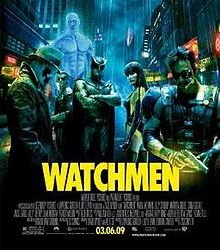
A movie adaptation of Watchmen had been in development in some form or another since the graphic novel was first published back in 1987. Over the course of its two decade development cycle, being passed from filmmaker to filmmaker who each had their own vision of what a Watchmen movie should be, fans objected to the idea of a movie adaptation, describing Watchmen as ‘unfilmmable.’ Alan Moore himself condemned the effort to adapt his work, saying that Watchmen does things that can only be done in a comic book. But where there’s a will, there’s a way, and in 2009, Watchmen finally came to the big screen, directed by Zack Snyder.
I confess it took me a lot longer to write this review than I intended and that’s largely because I wasn’t sure how best to approach it. Snyder clearly has a lot of love and respect for the source material and tried his best to honour it as best he could. Snyder himself even said that he considers the film to be an advert for the book, hoping to get newcomers interested in the material. So how should I be looking at this film? As an adaptation or as an artistic tribute? More to the point, which of the three versions of the film should I be reviewing? The original theatrical cut, the director’s cut or the ultimate cut? Which best reflects Snyder’s artistic vision?
After much pondering, I decided to go with the director’s cut. The theatrical release was clearly done to make studio execs happy by keeping the runtime under three hours, but it comes at the cost of major plot points and character moments being chucked away. The ultimate cut however comes in at a whopping four hours and is arguably the most accurate to the source material as it also contains the animated Tales Of The Black Freighter scenes. However these scenes break the narrative flow of the film and were clearly not intended to be part of the final product, being inserted only to appease the fans. The director’s cut feels most like Snyder’s vision, clocking in at three and half hours and following the graphic novel fairly closely whilst leaving room for artistic licence.
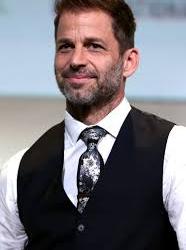
Now as some of you may know, while I’m not exactly what you would call a fan of Zack Snyder’s work, I do have something of a begrudging respect for him due to his willingness to take creative risks and attempt to tell more complex, thought provoking narratives that don’t necessarily adhere to the blockbuster formula. Films like Watchmen and Batman Vs Superman prove to me that the man clearly has a lot of good ideas and a drive to really make an audience think about what they’re watching and question certain things about the characters. The problem is that he never seems to know how best to convey those ideas on screen. In my review of Batman Vs Superman, I likened him to a fire hose. Extremely powerful, but unless you’ve got someone holding onto the thing with both hands and pointing it in the right direction, it’s just going to go all over the place. I admire Snyder’s dedication and thought process, but I think the fact that his most successful film, Man Of Steel, also happens to be the one he had the least creative influence on speaks volumes. When he’s got someone to work with and bounce ideas off of, he can be a creative force to be reckoned with. Left to his own devices however, and his films tend to go off the rails very quickly.
Watchmen is very much Snyder’s passion project. You can tell a lot of care and effort went into this. The accuracy of the costumes, staging and set designs speak for themselves. However there is an underlying problem with Snyder trying to painstakingly recreate the graphic novel on film. While I don’t agree with the purists who say that Watchmen is ‘unfilmmable’, I do agree with Alan Moore’s statement that there are certain aspects of the graphic novel that can only work in a graphic novel. A key example of this is its structure. Watchmen has the luxury of telling its non-linear narrative over twelve issues in creative and unorthodox ways. A structure that’s incredibly hard to translate into any other medium. A twelve episode TV mini-series might come close, but a movie, even a three hour movie, is going to struggle due to the sheer density of the material and the unconventional structure. Whereas the structure of the graphic novel allowed Alan Moore to dedicate whole chapters to the origin stories of Doctor Manhattan and Rorschach and filling in the gaps of this alternate history, the structure of a movie doesn’t really allow for that. And yet Snyder tries really hard to follow the structure of the book even though it simply doesn’t work on film, which results in the movie coming to a screeching halt as the numerous flashbacks and origin stories disrupt the flow of the narrative, causing it to stop and start constantly at random intervals, like someone kangarooing in a rundown car.
Just as Watchmen the graphic novel played around with the common tropes and framing devices of comics, Watchmen the movie needed to play around with the common tropes and framing devices of comic book movies. To Snyder’s credit, there are moments where he does do that. The most notable being the first five minutes where we see the entire history of the world of Watchmen during the opening credits while ‘The Times They Are A-Changing’ is played in the background. This is legitimately good. It depicts the rise and fall of the superhero in a way only a movie can. I wish Snyder did more stuff like this rather than restricting himself to just recreating panels from the graphic novel.
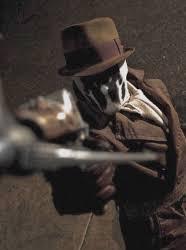
Which is not to say I think the film is bad. On the contrary, I think it’s pretty damn good. There’s a lot of things to like about this movie. The biggest, shiniest gold star has to go to Jackie Earle Haley as Rorschach. While the movie itself was divisive at the time, Haley’s portrayal of Rorschach was universally praised as he did an excellent job bringing this extreme right wing bigot to life. He has become to Rorschach what Ryan Reynolds is to Deadpool or what Mark Hamill is to the Joker. He is the character (rather tragically. LOL). To the point where it’s actually scary how similar Haley looks to Walter Kovacs from the graphic novel. The resemblance is uncanny.
Another standout performance is Jeffery Dean Morgan as the Comedian. Just as depraved and unsavoury as the comic version, but Morgan is also able to inject some real charm and pathos into the character. You believe that Sally Jupiter would have consensual sex with him despite everything he did to her before. But his best scene I think was his scene with Moloch (played by Matt Frewer) where the Comedian expresses regret for all the terrible things he did. It’s a genuinely emotional and impactful scene and Morgan manages to wring some sympathy out of the audience even though the character doesn’t really deserve it. But that’s what makes Rorschach and the Comedian such great characters. Yes they’re both depraved individuals, but they’re also fully realised and three dimensional. They feel like real people, which is what makes their actions and morals all the more shocking.
Then there’s Doctor Manhattan, who in my opinion stands as a unique technical achievement in film. The number of departments that had to work together to bring him to life is staggering. Visual effects, a body double, lighting, sound, it’s a truly impressive collaborative effort, all tied together by Billy Crudup’s exceptional performance. He arguably had the hardest job out of the whole cast. How do you portray an all powerful, emotionless, quantum entity without him coming across as a robot? Crudup manages this by portraying Manhattan as being less emotionless and more emotionally numb, which makes his rare displays of emotion, such as his shock and anger during the TV interview, stand out all the more. It’s a great depiction that I don’t think is given the credit it so richly deserves.

Which leads into something else about the movie, which will no doubt be extremely controversial, but I’m going to say it anyway. I much prefer the ending in the film to the ending in the book.

Hear me out.
In my review of the final issue of Watchmen, I said I didn’t like the squid because of its utter randomness. The plot of the movie however works so much better both from a narrative and thematic perspective. Ozymandias framing Doctor Manhattan makes a hell of a lot more sense than the squid. For one thing, it doesn’t dump a massive amount of new info on us all at once. It’s merely an extension of previously known facts. We know Ozymandias framed Manhattan for giving people cancer to get him off world. It’s not much of a stretch to imagine the world could also buy that Manhattan would retaliate after being ostracised. We also see Adrian and Manhattan working together to create perpetual energy generators, which turn out to be bombs. It marries up perfectly with the history of Watchmen as well as providing an explanation for why there’s an intrinsic field generator in Adrian’s Antarctic base. It also provides a better explanation for why Manhattan leaves Earth at the end despite gaining a newfound respect for humanity. But what I love most of all is how it links to Watchmen’s central themes.
Thanks to the existence of Doctor Manhattan, America has become the most powerful nation in the world to the point where its disrupted the global balance of power. This has led to the escalation of the Cold War with Russia as well as other countries like Vietnam being at the mercy of the United States. It also allowed Nixon to stay in office long after his two terms had expired. The reason the squid from the book is so unsatisfying as a conclusion is because you don’t buy that anyone would be willing to help America after the New York attack. In fact it would be more likely that Russia and other countries might take advantage of America’s vulnerability. Manhattan’s global attack however not only gives the whole world motivation to work together, it also puts America in a position where they have no choice but to ask for help because it was they that effectively created this mess in the first place. So seeing President Nixon pleading for a global alliance feels incredibly satisfying because we’re seeing a corrupt individual hoist by his own petard and trying to save his own skin, even if it comes at the cost of his power. America is now like a wounded animal, and while world peace is ultimately achieved, the US is now a shadow of its former self. It fits in so perfectly with the overall story of Watchmen, frankly I’m amazed Alan Moore didn’t come up with this himself.
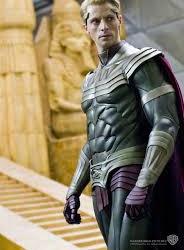
It’s not perfect however. Since the whole genetic engineering stuff no longer exists, it makes the existence of Adrian’s pet lynx Bubastis rather perplexing. Also the whole tachyons screwing with Doctor Manhattan’s omniscience thing still doesn’t make a pixel of sense. But the biggest flaw is in Adrian Veidt’s characterisation. For one thing, Matthew Goode’s performance isn’t remotely subtle. He practically screams ‘bad guy’ the moment he appears on screen. He has none of the charm or charisma that the source material’s Ozymandias had. But it’s worse than that because Snyder seems to be going out of his way to uncomplicate and de-politicise the story and characters. There’s no mention of Adrian’s liberalism or his disdain for Nixon and right wing politics. The film never explores his obsession with displaying his own power and superiority over right wing superheroes like Rorschach and the Comedian. He’s just the generic bad guy. And I do mean bad guy. Whereas the graphic novel left everything up to the reader to decide who was morally in the right, the film takes a very firm stance on who the audience should be siding with. Don’t believe me? Just look at how Rorschach’s death is presented to us.
It’s very clear while watching the film that Zack Snyder is a big Rorschach fan. He gets the most screen time and there’s a lot of effort dedicated to his portrayal and depiction. And that’s fine. There’s nothing necessarily wrong with that. As I’ve mentioned before in previous blogs, Rorschach is my favourite character too. However it’s important not to lose sight of who the character is and what he’s supposed to represent, otherwise you run the risk of romanticising him, which is exactly what the film ends up doing. Rorschach’s death in the graphic novel wasn’t some heroic sacrifice. It was a realisation that he has no place in the world that Ozymandias has created, as well as revealing the hypocrisy of the character. In the extra material provided in The Abyss Gazes Also, we learn that, as a child, Walter supported President Truman’s use of the atomic bomb in Hiroshima and Nagasaki, and yet, in his adult life, he opposes Adrian’s plan. Why? What’s the difference? Well the people who died in Hiroshima and Nagasaki weren’t American. They were Japanese. The enemy. In Rorschach’s mind, they deserved to die, whereas the people in New York didn’t. It signifies the flawed nature of Rorschach’s black and white view of the world as well as displaying the racist double standards of the character. Without the context of Hiroshima and Nagasaki, Rorschach’s death becomes skewed. This is what ends up happening in the movie. Rorschach removes his mask and makes a bold declaration to Doctor Manhattan, the music swells as he is disintegrated, defiant to the last, and his best friend Nite Owl screams in anguish and despair.
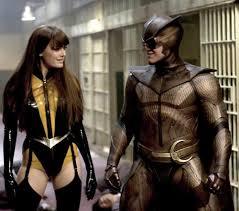
In fact the film takes it one step further by having Nite Owl punch Adrian repeatedly in the face and accuse him of deforming humanity, which completely contradicts the point of Dan Dreiberg as a character. He’s no longer the pathetic centrist who requires a superhero identity to feel any sort of power or validation. He’s now the everyman representing the views of the audience, which just feels utterly wrong.
This links in with arguably the film’s biggest problem of all. The way it portrays superheroes in general. The use of slow motion, cinematography and fight choreography frames the superheroes and vigilantes of Watchmen as being powerful, impressive individuals, when really the exact opposite should be conveyed. The costumes give the characters a feeling of power, but that power is an illusion. Nite Owl is really an impotent failure. Rorschach is an angry bigot lashing out at the world. The Comedian is a depraved old man who has let his morals fall by the way side so he can indulge in his own perverse fantasies. They’re not people to be idealised. They’re to be at pitied at best and reviled at worst. So seeing them jump through windows and beating up several thugs single handed through various forms of martial arts ultimately confuses the message, as does the use of gratuitous gore and violence. Are we supposed to be shocked by these individuals or in awe?
Costumes too have a similar problem. Nite Owl and Ozymandias’ costumes have been updated so they look more imposing, which kind of defeats the purpose of them. The point is they look silly to us, the outside observers, but they make the characters feel powerful. That juxtaposition is lost in the film. And then there’s the Silk Spectre. In the graphic novel, both Sally and Laurie represent the changing attitudes of women in comics and in society. Both Silk Spectres are sexually objectified, but whereas Sally accepts it as part of the reality of being a woman, Laurie resists it, seeing it as demeaning. The only reason she wore her revealing costume in A Brother To Dragons was because she knew that Dan found it sexually attractive and she wanted to indulge his power fantasy. None of this is touched upon in the film, other than one passing mention of the Silk Spectre porn magazine near the beginning of the film. There’s not even any mention of how impractical her costume is, like the graphic novel does. Yes the film changes her look drastically, but it’s still just as impractical and could have been used to make a point on how women are perceived in comic book films, but it never seems to hinder her in anyway. It’s never even brought up, which is ridiculous. Zack Snyder’s reinterpretation of Silk Spectre is clearly meant to inject some form of girl power into the proceedings, as she’s presented as being just as impressive and kick-ass as the others, when the whole point of her character was to expose the misogyny of the comics industry at the time and how they cater to the male gaze. Now don’t get me wrong, I’m not saying the graphic novel did it perfectly, but it did it a hell of a lot better than this.
Die hard fans have described the film over the years as shallow and ‘style over substance.’ I don’t think that’s entirely fair. It’s clear that Zack Snyder has a huge respect for the graphic novel and wanted to do it justice. Overall the film has a lot of good ideas and is generally well made. However, as much as Snyder seems to love Watchmen, it does seem like he only has a surface level understanding of it, hence why the attention and effort seems to be going into the visuals and the faithfulness to Alan Moore’s attention to detail rather than the Watchmen’s story and themes. While the film at times makes some good points about power, corruption and morality, it doesn’t go nearly as far as the source material does and seems to shy away from really getting into the meat of any particular topic. Part of that I suspect is to do with marketability, not wanting to alienate casual viewers, but I think a lot of it is to do with it simply being in the wrong medium. I personally don’t think you can really do a story as complex and intricate as Watchmen’s justice in a Hollywood film. In my opinion, this really should have been a TV mini-series or something.
So on the whole, while I appreciate Snyder’s attempt at bringing the story of Watchmen to life and can see that he has the best intentions in mind, I don’t think this film holds a candle to the original source material.
21 notes
·
View notes
Text
Above and Beyond | Sovereign by April Daniels

Started: February 15th, 2019
Finished: February 17th, 2019
Sovereign [Goodreads] went above and beyond the foundations laid by its predecessor. This is a novel that starkly plays out the effects of its previous installment adding more depth and nuance to its characters than I thought possible and ultimately culminated in a deeply satisfying sequel.
Sovereign takes place months after the ending of the first book in the Nemesis series, Dreadnought. At the start of the book, Danny has truly come into her own as a superhero, she’s seemingly at the top of her game with public support and the respect of her fellow capes. But under the surface, Danny is dealing with a rage that causes her to toe the line of hero more often than not. Her PTSD from both growing up in an abusive household and caping is compartmentalized and ignored and her relationships are deteriorating. With a new supervillain threat on the horizon, Danny has to deal with both the repercussions of her superhero life and that looming evil presence.
What’s standout in this sequel is April Daniels’s willingness to address the fall out of the last book in the series. There are real consequences to what Danny went through and we see them all in gritty detail. Danny’s brutal rage and often cruel behavior is sympathetic because April Daniels explores where it comes from. Daniels never excuses or glorifies the extreme violence Danny herself relishes in but unpacks where those feelings come from. We are truly in Danny’s mind and while we might not love what we see it was hard for me not to respond to it with anything less than radical empathy.
This book goes to a darker place than I expected it to, we delve into the dark side of Danny’s psyche and see her at her absolute lowest and see her become better and find her strength, not through her physical power but in her friends and in her genuine desire to do good. I don’t have all the wards to describe how emo this metamorphosis made me.
I loved the antagonists of this book. Our primary antagonist, Sovereign initially felt like a generic rich asshole, yet Daniels managed to capture the kind of people who become neofascists extremely accurately. I’ve spent a lot of time watching deconstructions modern white supremacy and the personalities who grift off of it and Daniels boils down their talking points and how they see the world succinctly. I tip my hat to that.
Our other antagonist, Greywytch (Queen of the TERFs) was such a powerful symbol. The Nemesis series, like most superhero narratives, are power fantasies and I don’t mean that in a derogatory way. There is so much catharsis in seeing an individual in the margins of society gain the power to stand against people would see her erased. Watching a trans girl find the strength to show compassion to someone who sees her as less than human, to win the fight, not my punching harder but by refusing to play the game they designed has so much power and I loved it.
The worldbuilding in this series while stock-standard superhero world in some ways is filled to the brim with originality and creativity in others. Daniels fills her world with details that I find fascinating and often aren’t addressed in blockbuster superhero spectacles. I for one really loved the discussion of the different relationships capes have with the police and the government. Or how contract work differs from superhero to superhero and how their individual backgrounds can give them different privileges. It’s small details like this that make this superhero world feel lived in and thought through rather than artificial and derivative.
There are so many small things to love about this book. The fact that Daniels surrounds our protagonists with adults who while not perfect love and support Danny. The beautifully awkward romance between Danny and Sarah. The nods to comic history embedded in Daniel’s word building. I could really feel a lot of the care that went into crafting this book.
Stars 🌟🌟🌟🌟¹⁄₂
I loved Sovereign so much. I hope we get to see more of April Daniels’s world because this was absolutely fantastic and I know wherever she takes the story next it will be just as interesting and intricate.
–––––––––––––––––––––––––––––––
Content Warning: transphobia, parental abuse, graphic torture
8 notes
·
View notes
Note
I just finished ‘Becoming’ and I absolutely loved it! I just wondered if you believe that AtG and Hephaistion continued their romantic relationship throughout their lives or if you think they let that side of their friendship go as they got older as was more common at the time? Anyway! I absolutely loved ‘Becoming’ and I can’t wait to read ‘Rise’!
I’m guessing you’re asking about the historical people, as opposed to the fictional characters? I do hope/plan to continue the Dancing with the Lion series, and in it, yes, they will remain romantically involved. Whether or not future novels are bought, however, rests on how well Becoming and Rise do. (So if you want more, get the word out and post reviews. *grin*)
Yet, with regard to the historical men, I think it’s very hard to know whether they remained sexual partners as adults. And the reason it’s hard to know involves the difficulty of our surviving sources.
As soon as historians start talking SOURCES, a lot of folks tune out. It’s BORING. *grin* But in order to give an honest answer, I kinda have to Go There.
First, let me give the TL;DR version. If they were still sexually involved as adults, I suspect it was quite occasional. And the fact it was quite occasional (if at all), may be why we don’t hear anything about it in the sources (discussion to follow). After all, they were both extremely busy men with duties and responsibilities that sometimes kept them apart for months. If they were still sexually/romantically involved, they had what we’d today call a long-distance relationship at points…and without the benefit of cell phones.
It may have been a gradual “weaning” from each other, rather than anything sharp. So they may have been lovers as teens, then over time, each took younger beloveds, and finally, wives—all while remaining emotionally very, very close. (Although I suspect that, like any friendship OR love affair, they had ups-and-downs, fights and reconciliations.)
Now, here’s why the TL;DR summary above gets a big fat label: “SPECULATION.”
The sources are the only way we know anything about the past, and if they can’t be trusted, or at least not trusted in toto, we have a Really Big Problem. So let me lay it out.
Before I do, however, I want to remind readers that I DO think Alexander and Hephaistion were lovers, at least in their youth. But no, it’s not “obvious.” Theirs wasn’t a world especially reticent about same-sex affairs (*cough* see below), even if post-Christian, modern historians had trouble with it until the last 40 years or so. So if the (surviving) ancient authors don’t talk about them as lovers, even while discussing other same-sex pairs in the same damn text, we have to ask…why? One very real possibility is that they didn’t talk about them as lovers because they weren’t. Full stop. There could have been other reasons (I think there were), but let’s not flinch from being honest, here.
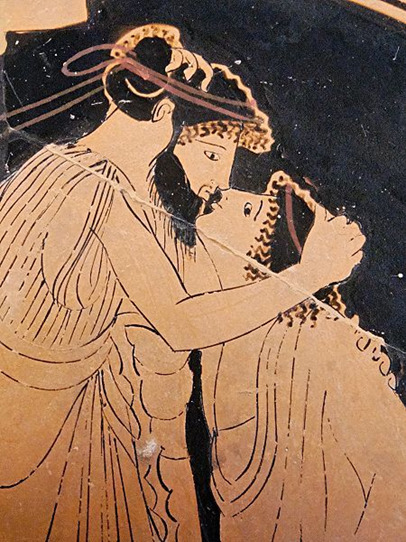
(This could have been a lot more graphic, but then I’d have to post a warning on my blog.)
So…back to our Persnickety Sources.
First, nothing has survived that Alexander wrote himself. We have a couple public inscriptions, but not one piece of writing, even a letter, from Alexander. (Any surviving letters are quoted in later sources, and probably aren’t real.*)
Second, nothing has survived written by anyone who actually knew Alexander, or even lived when he did, except forensic speeches from Athenian demagogues who mostly hated him (and weren’t writing histories anyway). One may as well trust Demosthenes on Philip.
The sources we do still have used histories written by those who knew Alexander, such as Ptolemy, Aristobulos, Nearchos, Marsyas, and even the court historian, Kallisthenes. They also used other texts of dubious worth, such as Onesikritos, who was made fun of even in his own day for writing “historical fiction.” And sometimes our later authors were using texts who, themselves, were using earlier texts. So we’ve got three (or more) layers, not just two!
Third, we have not just layers of sources, but layers in the CULTURE behind those sources.
The first layer is, of course, Macedonian. How did the Macedonians themselves view Alexander? We don’t know—not truly. Nothing survives from a Macedonian source, such as Marsyas or Ptolemy. (Some of you “in the know” might be thinking, But Polyaenus! No. Polyaenus lived 500 years after ATG; that was a very different Macedonia. [Yes, I used the Latin spelling, as he was Roman. ;p])
The second layer is Greek, but we have to qualify this. Layer 2.0 is Greece of the 4th century, especially Athenian reactionism, writing about the emerging Macedonian kingdom. There could be huge cultural differences even among Greek city-states. Case in point: Athens vs. Sparta. Greeks didn’t always understand Macedonians (sometimes, I swear, on purpose).
BUT we also have the increasingly homogenized Hellenistic world of the Successors, which was sorta like when you throw in a bunch of different colored shirts and wash them in hot water. You get a color-bleeding mess. Your red shirt (Attic-Ionic) might have a big blue streak (Doric) on it now. That’s sort of what happened to Greek culture as the Hellenistic era progressed. Lots of bleed. This had begun prior to Alexander, but he accelerated it like kerosene on a trash fire. We can call that Greek Layer 2.1, or something.
Then we have the Romans, and their culture, which, if similar to Greek, definitively wasn’t Greek in key ways. All our surviving sources were written as the Republic was collapsing and the Empire emerging, and by that point, Greece was a Roman province.
Again, we’ve got two groups here: Greeks living under Roman rule, such as Plutarch, Diodorus, and Arrian—who wrote in Greek—and then Roman authors such as Curtius, and later Justin, who wrote in Latin. But the Greeks under Rome shouldn’t be conflated with Athenians in ATG’s own day, or even under the Successors. The culture evolved and took on Roman shadings.
So that’s not just layers of sources, but layers of cultures trying to understand what people who lived a hundred or two hundred or three hundred years before them thought/believed.
Ergo, are we hearing what Alexander (or anybody else around him) really thought or intended? Or just what writers of the Second Sophistic (such as Plutarch) wanted him to model? Or how even later authors, such as Arrian, wanted to use him to flatter his patron, Hadrian?
What’s Roman, what’s Greek, and what’s Macedonian? Can we tease that out? I’d say it’s damn tricky, and often, flat impossible—although unlike some of my colleagues, I don’t believe it’s all Roman overlay. That goes too far in the other direction, IMO.
Last, we have several authors who weren’t writing about Alexander specifically, but have bits of Alexander lore embedded in their texts: Athenaeus’s “Supper Party,” or Polyaenus’s “Strategems,” or even Plutarch’s “Moralia,” just to name three.
Among these, especially later, we have authors writing material they (or later readers) tried to pass off as written by earlier authors. We often refer to these authors with the preface “Pseudo-” as in “Pseudo-Kallisthenes.” It was NOT written by Kallisthenes, but was later attributed to him.
So, now you have some idea of why Alexander historians want to pull our hair out!
But I detail that to explain why it’s so hard for me to give you any clear answer about whether Alexander and Hephaistion remained lovers as adults. Or even if they were lovers at all.
In none of our five primary histories of Alexander, nor in Plutarch’s other stuff, nor Athenaeus, etc. is Hephaistion ever called Alexander’s lover. This includes sources that do mention with apparent unconcern other pairs of male lovers. So this isn’t “the love that dared not speak it’s name.” The Greeks were pretty okay with talking about their boyfriends.
There could be OTHER reasons for deep-sixing mention of Hephaistion and Alexander as lovers, mostly having to do with status (some of which I touched on in the novels), yet the lack of clear affirmation is a problem. The only mentions we do have come from late sources, one of which belongs to that category of “pseudo-” authors I mentioned: Pseudo-Diogenes (in Aelian), as well as Arrian recording the Stoic Epiktatos. The philosophers are trying to make a point about the dangers of giving in to physical desire, so it’s hard to know how much credit to give these references.
Thus, we’re left with little besides the indirect (e.g., the Achilles-Patroklos allusions, etc.). Those have their own problems, which I’ll not go into now, as I’ve already written a small essay.
One potential reason for a lack of mention in our surviving sources is that any sexual love affair had been a product of their youth. What remained was a fiercely deep and passionate devotion. Before you pooh-pooh that—Of course they were still having sex!—consider modern marriages that have lasted for decades but no longer include sexual activity, at least between the married partners. Don’t be sucked in by Romance novel tropes.
When I was doing bereavement counseling (et al.), I ran into all sorts of arrangements that married couples made across time. Some marriages break up when the partners stop being sexually attracted to each other, and “cheat.” But others don’t, because it’s not “cheating” if it’s mutually agreed to. Or in some cases, the partners simply lost interest in sex as they aged…but didn’t fall out of love with each other. So they might have sex once a year? Maybe? That was enough. Or they had sex on the side, with permission. People don’t fit into boxes well, IME. Honesty was the hallmark of marriages that lasted even when they weren’t still having sex. I’ve known of marriages where the couples had stopped having sex years ago, but when one of them died, the other was completely devastated because of the enormous EMOTIONAL investment. I think that’s what hit Alexander when Hephaistion died. Maybe they were still having sex, at least once in a blue moon. Maybe they weren’t. That didn’t matter.
LOVE is deeper than sex, by a long shot. Which is why the Greeks counted PHILIA (true friendship) as the superior love to eros (desire).
So whether Alexander and Hephaistion were still sexually involved—or had ever had sex—doesn’t reflect the depth of their love for each other. We might not be told by the sources that they were lovers, physically, either as youths or continuing into adulthood. But the sources are abundantly clear that they loved each other best of all. When Hephaistion died, Alexander followed him about 10 months later.
(Final note: what I intend to do in the series, going forward, is a bit different from what I described here, but that’s why I specified this involves the historical men, not necessarily my fictional characters.)
*My reference to quoted material, such as letters—or speeches—not being real: it was a common practice in the ancient world for the author of histories, especially starting with Thucydides, to just MAKE SHIT UP. It was all about showing off one’s own rhetorical skills. I think, in a lot of cases, we are probably getting at least the gist of what was said. But NEVER, EVER, EVER trust the “transcription” of an ancient speech…unless it was actually recorded later by the author. So, say, Demosthenes’ Philippics are probably a cleaned up version of the speeches he delivered. But Alexander’s “Speech at Opis” is NOT what Alexander actually said.
#Alexander the Great#Alexanderthegreat#Hephaistion#Hephaestion#Dancing with the Lion#DwtL#Homoeroticism in the ancient world#Alexander x Hephaistion#alexander x hephaestion#Classics#tagamemnon#ancient history#historiography#asks
60 notes
·
View notes
Text
Cramp’s Comic Recommendations For Fans Of Classic Rock And Co.
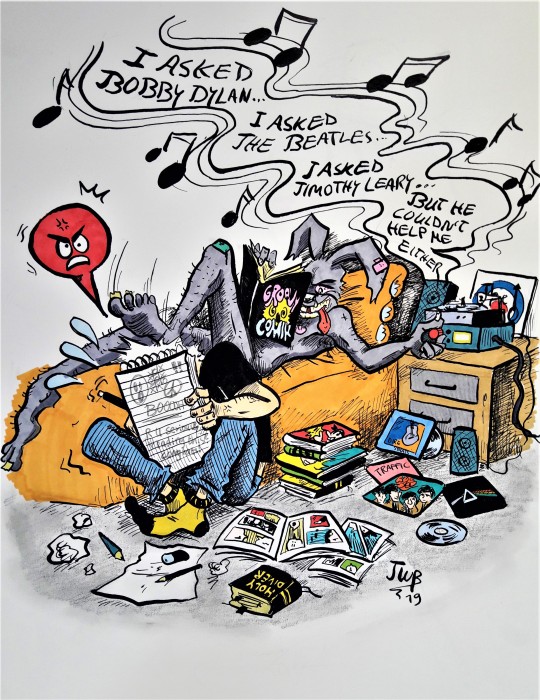
Allright here we go. This is my current list of comics/manga/graphic novels you might enjoy if you’re into classic rock. Before we get started I’d just like to let you all know:
- This list is far from being complete. I’m sure there are many more groovy comics out there that I’m simply not aware of yet so if you have any suggestions feel free to add them :)
- I know I said “Classic Rock” but some of my choices may drift into other musical directions
- Needless to say I do not own any of the following images. They all belong to their rightfull owners and I’ll use them as visual reference material only.
- Sorry for eventual misspelling
Let’s go ^^
1. Bob Dylan Revisited
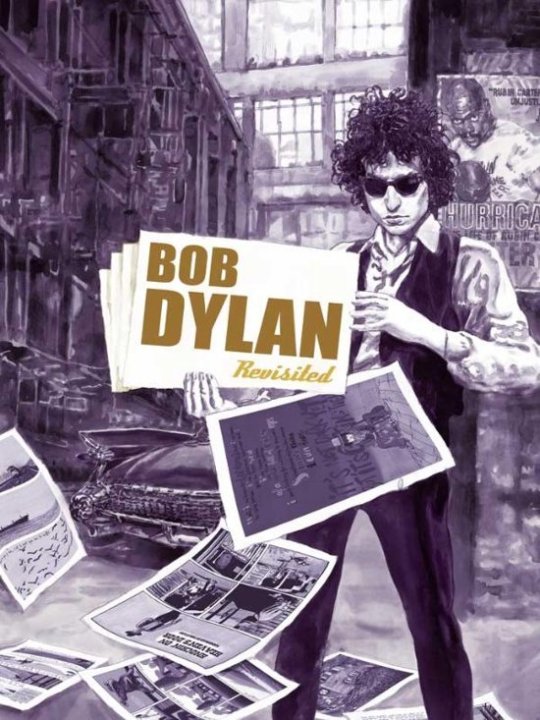
Let’s start with an obvious choice. This is a collection of 13 well-known Dylan Songs, each of them graphically interpreted by a different artist. The most striking feature therefore is the high variety of different art styles. Some of them are cartoony, some are very abstract while others are almost photo realistic.
Dylan’s mesmerizing lyrics have always been inspirational and these beautiful depictions truly are a sight to see.
Including works of Thierry Murat, Lorenzo Mattotti, Nicolas Nemiri, François Avril, Jean-Claude Götting, Christopher, Bézian, Dave McKean, Alfred, Raphaëlle Le Rio, Maël Le Mae, and Henri Meunier, Gradimir Smudju, Benjamin Flao, Jean-Phillippe Bramanti and Zep.
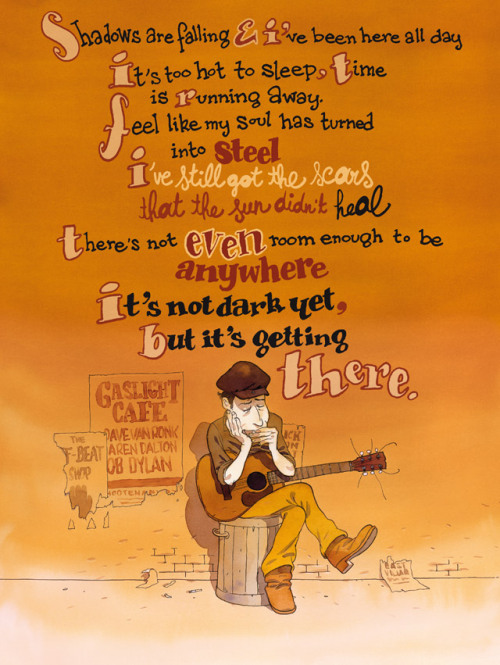
Zep’s take on “Not Dark Yet”
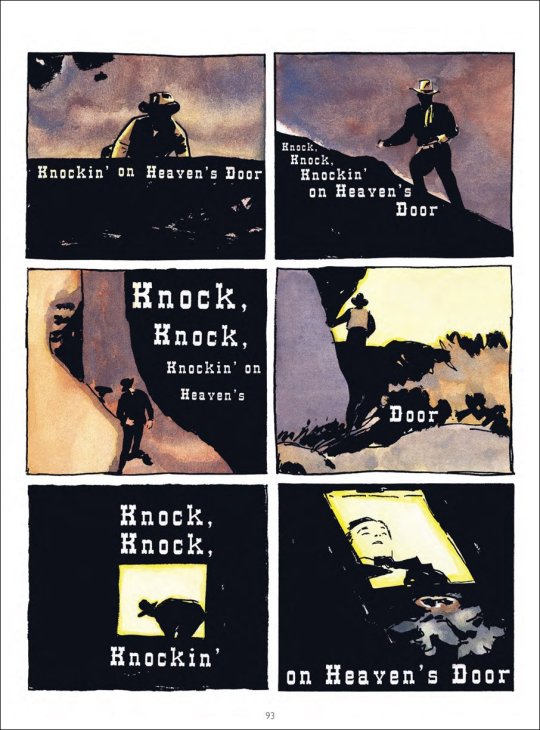
Jean-Phillippe Bramanti’s interpretation of “Knocking On Heaven’s Door”
Definitely worth checking out not only for Bob Dylan Fans.
2. Baby’s In Black” by Arne Bellstorf
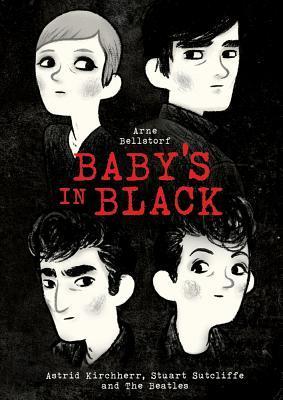
I’ve seen several people in the Beatles fandom complain about the lack of Stuart Sutcliffe material when it comes to early Beatles history.
Well, here it is: a graphic novel that focuses on the relationship between Stuart Sutcliffe and fotographer Astrid Kirchherr who took the very first professional photos of the Beatles during their time in Hamburg (1960-61).
Told mostly from Astrid’s point of view this comic presents itself in a grey and melancholic tone that fits the rather sad story. Bellstorf’s drawings are simplified and charming (they remind me of early sixties children book illustrations which suits the setting’s time period)
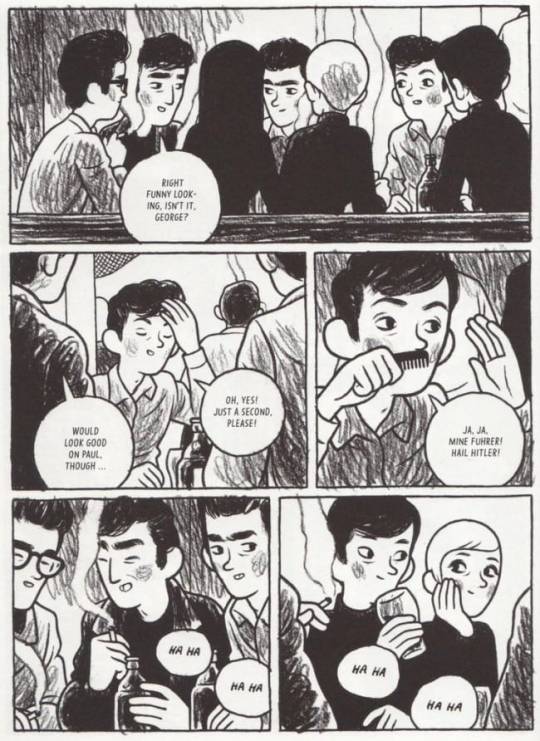
If you’re interested in early Beatles history (especially their Hamburg days) you should give this one a try.
3. Blue Monday by Chynna Clugston Flores
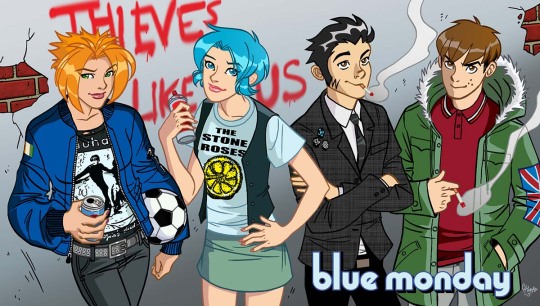
I really wish I had known about this amazing comic series a few years earlier, not only because this is a slice of life/coming of age story with teenage characters who are actually likeable and relateable but also because “Blue Monday” is an overall highly entertaining depiction of early nineties teen culture/rebellion in an American suburb that comes with a lot of references to Britpop, mod culture, Buster Keaton movies and Adam Ant (to name only a few).
To quote the author herself: “It’s like Archie on crack, with cursing and smokes”.
The art style of Chynna Clugston Flores is very vivid and expressive and has a certain stylistic touch of anime/manga (like a lot of comics from the early 2000s). I also really enjoy all of the graphic fashion details in this one. Plus, this is the first comic with it’s own soundtrack and that’s always a nice bonus.
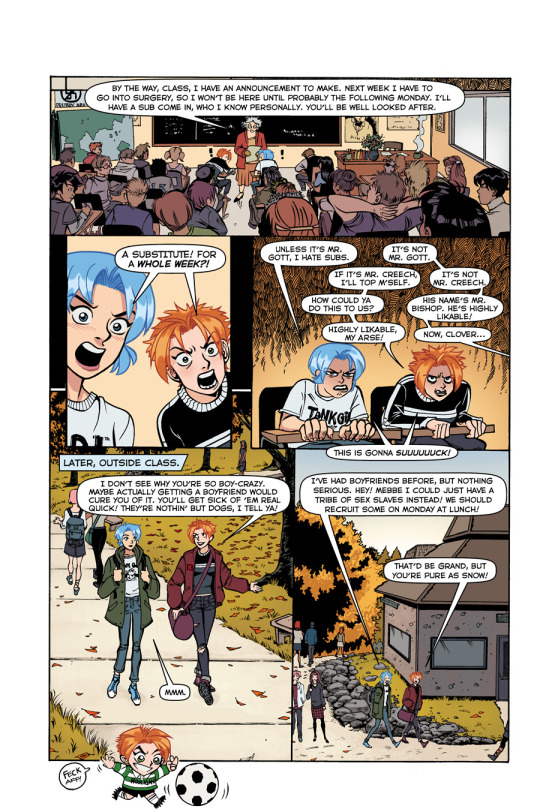
I’d recommend “Blue Monday” for fans of Britpop, Punk, New Wave and early 1990′s culture.
4. Punk Rock And Trailer Parks by Derf Backderf
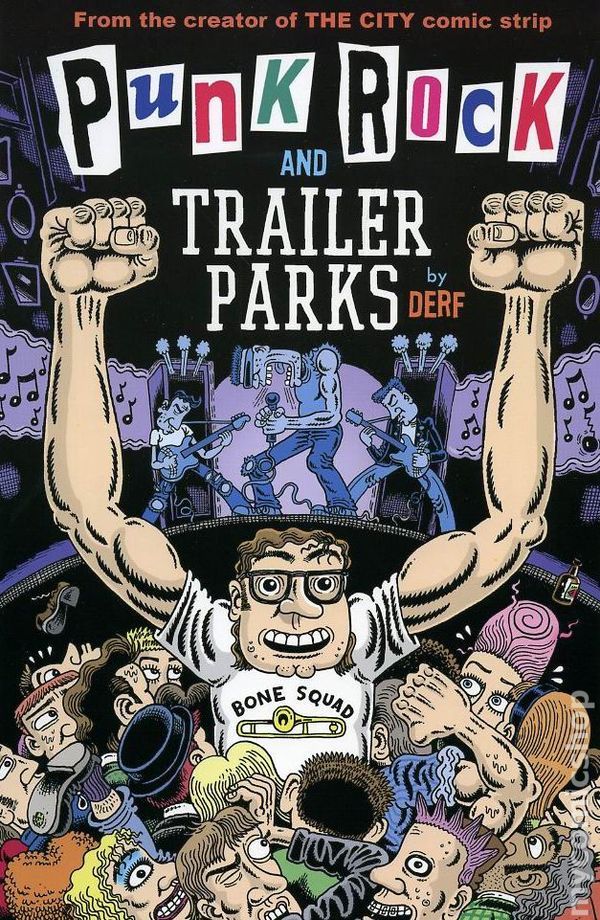
Another story about growing up in American small town madness, this time set in 1980s gritty Punk subculture of the former rubber city of Akron, Ohio. Protagonist Otto who likes to refer to himself as “The Baron” becomes fascinated with Punk after attending a Ramones concert. He meets several Pubk icons (thus as The Clash, The Plasmatics, rock journalist Lester Bangs and many more) and becomes someting of a local punk star himself.
Derf Backderf (who is best known for his highly acclaimed graphic novel “My Friend Dahmer” and his Eisner award winning comic “Trashed”) created a comic that is as “raw and dirty as punk itself”. His art style is an unique combination of expressionism, underground cartoons and punk magazines.
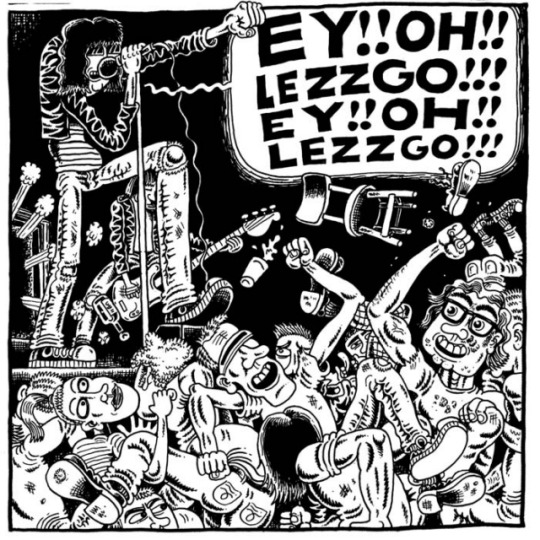
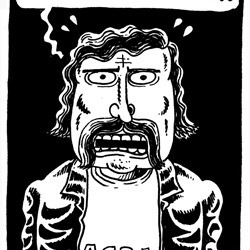
“Punk Rock And Trailer Parks” is a must-have for punk fans (especially if you’re into The Ramones and The Clash. It made me a huge fan of both of them).
5. “CASH - I See A Darkness” and “Nick Cave - Mercy On Me” by Reinhard Kleist
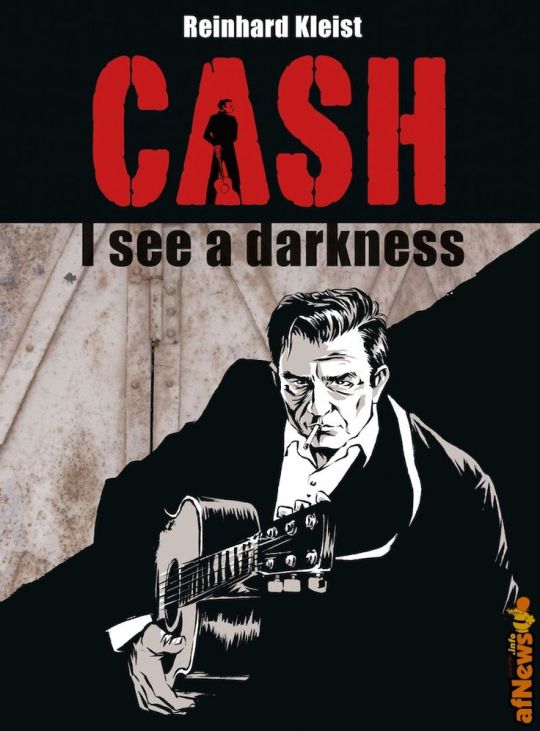
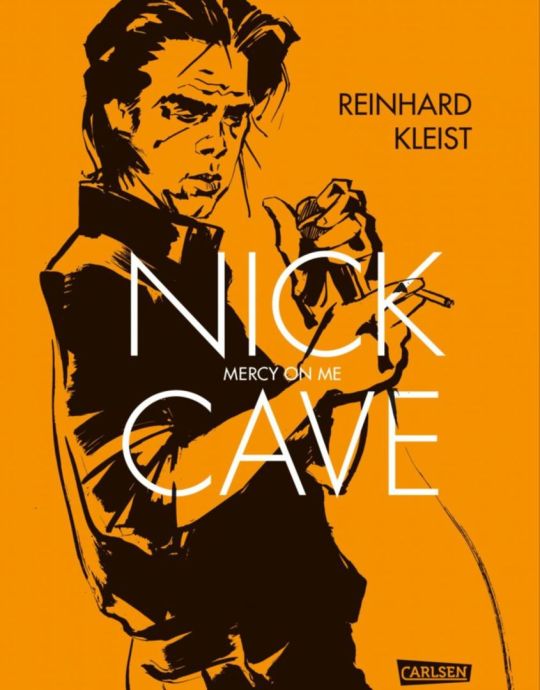
Two biographical graphic novels by Reinhard Kleist, both of them tell the story of a fascinating personality in rock history and both of them are incredibly well drawn. Kleist’s art is full of life and movement and very atmospheric due to his impressive use of stark contrasts.
I personally love his semirealistic way of drawing people and I’d highly suggest you to check out his other works too. He made a lot of biographical comics that really amazed me.
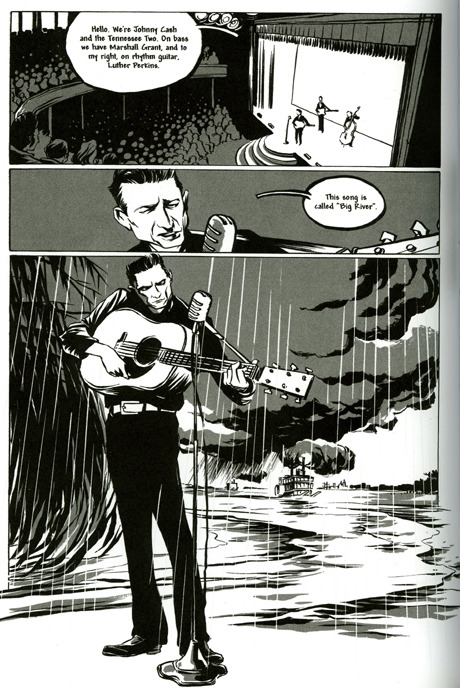
CASH

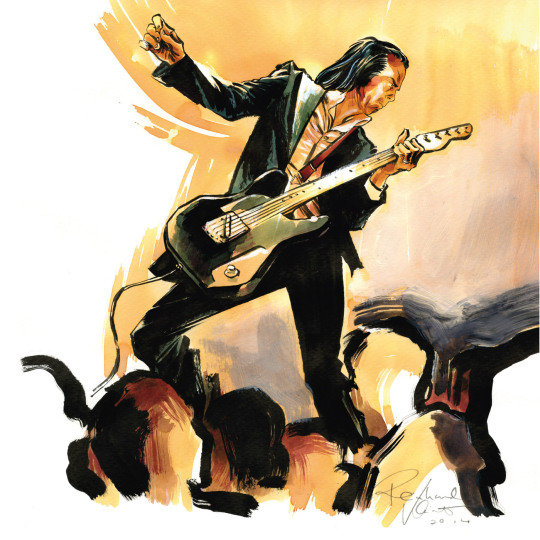
Cave
Definetly worth reading. Not only for Johnny Cash and Nick Cave fans.
6. Nowhere Men by Eric Stephenson, Nate Bellegarde, Jordie Bellaire and Fonografiks
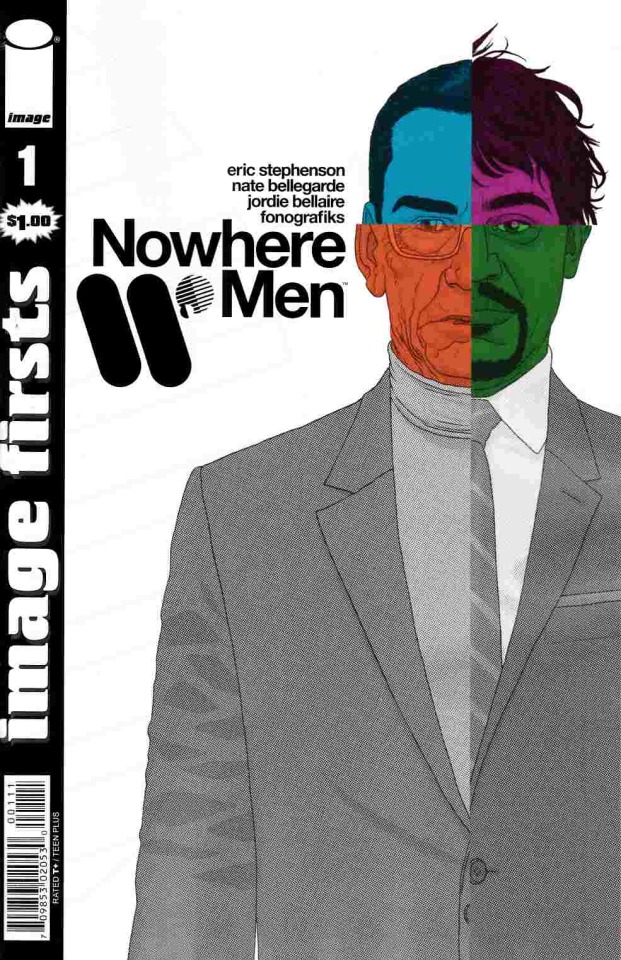
I talked about this one a while ago but I’ll gladly do it again since it’s just too cool. “Nowhere Men” is set in an alternative past/present and future where scientists became as popular as pop stars (catchphrase “Science is the new Rock n` Roll”) but somewhere along the way something definetly went wrong.
The hype of science shares obvious similarities with the beatlemania of the 60s and the founding of Apple back then. Furthermore, the characters are partly inspired by well-known personalities of Rock history. There are many more or less hidden nods and references to musical popculture wich is why I put it on this list.
Nowhere Men is a thrilling sci-fi dystopian that requires an observant reader because there is a lot of jumping back and forth i time and inbetween information. The art style is realistic and full of very vibrant colours.
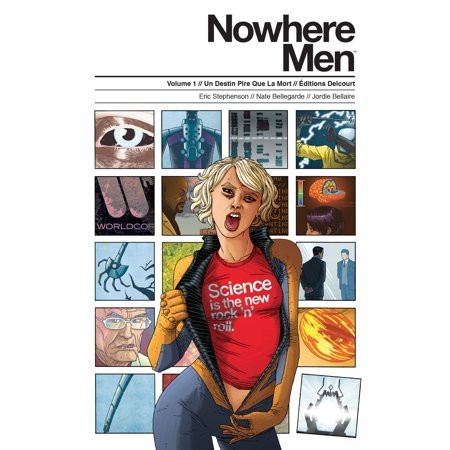
I found myself reading this multiple times to get all of the details in the world building. A thoughtful and brilliant writing indeed.
7. P.I.L. by Mari Yamazaki
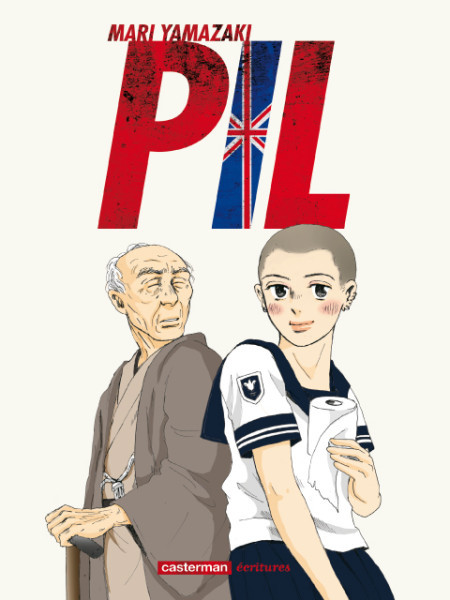
Japan 1983: 17-year-old Nanami couldn’t be more frustrated. Her grandfather loves to spend all of their household money on useless luxury junk and her strict school criticizes her messy hairstyle. Caught between teenage rebellion and responsibility as she tries different side jobs to earn at least a little bit of money, Nanami also has a thing for punk music and overall everything originated from England.
P.I.L. tells the story of conflict between two generations who aren’t as different as they might seem. Sometimes funny and heartwarming, sometimes with a bit of drama this is a charming slice of life/ coming of age josei with a more simplistic but aesthetical pleasing art style.
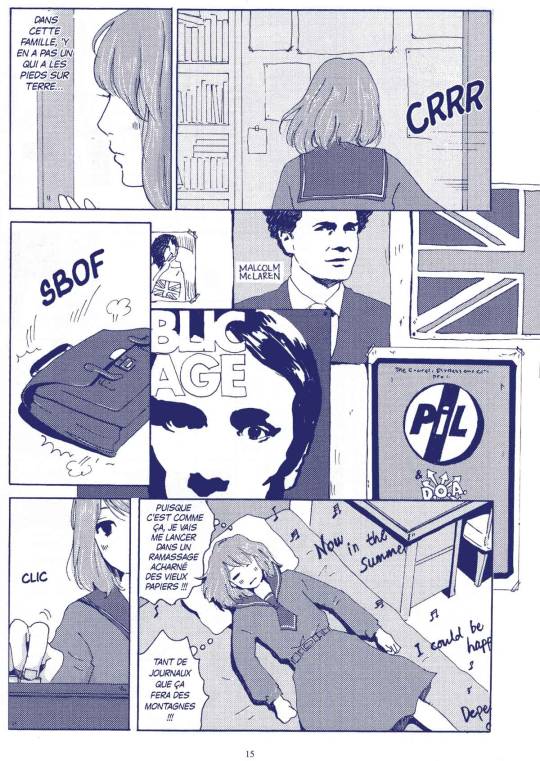
as the title might suggest, Nanami is a big fan of P.I.L. and other bands of the punk, neo punk and new wave movement such as The Stranglers and The Killing Joke
8. Yellow Submarine by Bill Morrison
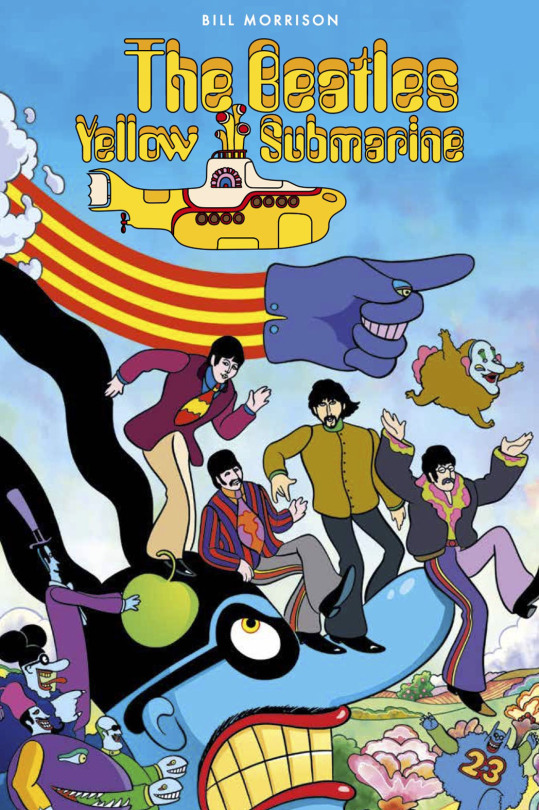
A comic adaptation of an animated film such as Yellow Submarine? Yeah, I was skeptical at first too but hear me out: This is really great. Morrison did an amazing job at capturing the trippy and psychedelic feeling of the legendary Beatles film. As the 1968 film used the medium of animation as an actual form of art to accomplish things only animation can do, Morrison did the same thing and used the advantages of the comic medium to accomplish things only comics can do. And it works. It really works.
Every single page of this colourful book has a different panel layout. Some of them are so beautiful and creative that I’d love to have a full-size poster version of them :’D
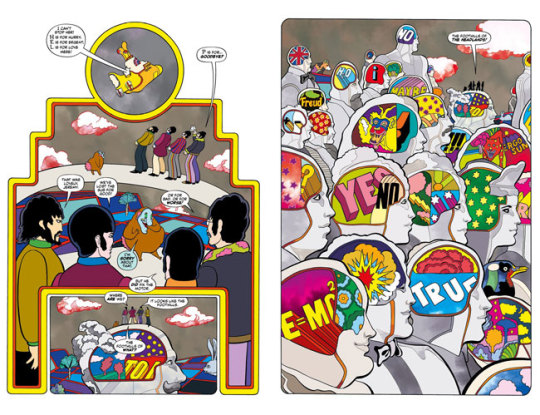
If you liked the film, if you love the psychedelic age, you’ll probably like the comic too.
9. In The Pines by Erik Kriek
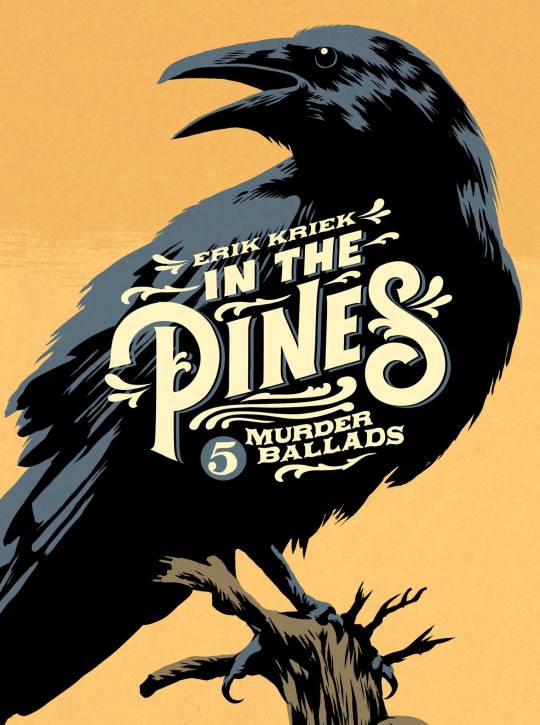
“In the pines, in the pines, where the sun never shines...”
5 Murder Ballads, some might call them dark Country Music, each of them beautifully illustrated by Erik Kriek. Atmospheric, dark and gritty and always on point to match the spine-chilling western-like storytelling of these ballads, great for fans of horror literature a la E.A.Poe.
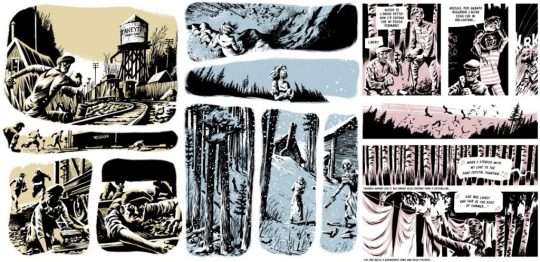
10. Andy - A Factual Fairy Tale by Typex
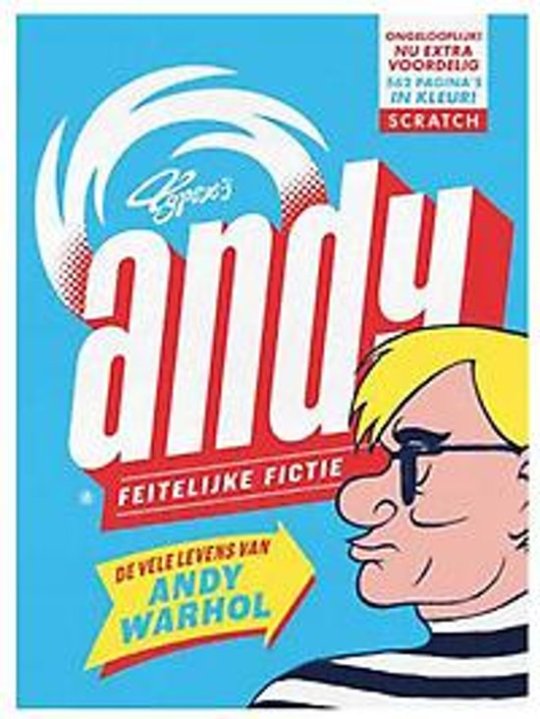
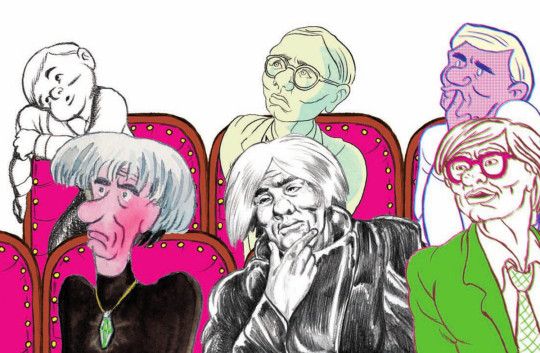
Allright folks this is it:
Typex’s “Andy” is by far one of the best comics/graphic novels I’ve ever red. It defenitely is my personal favourite reading of 2019 (and tbh I kinda doubt anything will top this anytime soon)
This is more than just a biographical take on of the most enigmatic pop-art artists of 20th centuary’s America, this is a portrait of the 20th centuary itself. There are so many references to art, history, literature, music and more that I could fill a book counting them all. And of course this is a monument for the medium of comic itself. Typex really managed to show what comic’s are capable of (At this point I’m really sorry I can’t explain it better I’m not good in writing stuff like this yet...)
Visually one of the most appealing things are the different art styles Typex manages to pull off so well for every chapter in Warhol’s life because each of them are a mirror of their zeitgeist. The introduction of Warhol’s childhood during the 30s is drawn in a cartoony style of old news paper comic strips. The chapter of 1967 has a psychedelic edge. The chapter of the early 60s shows similarities with the works of Roy Liechtenstein
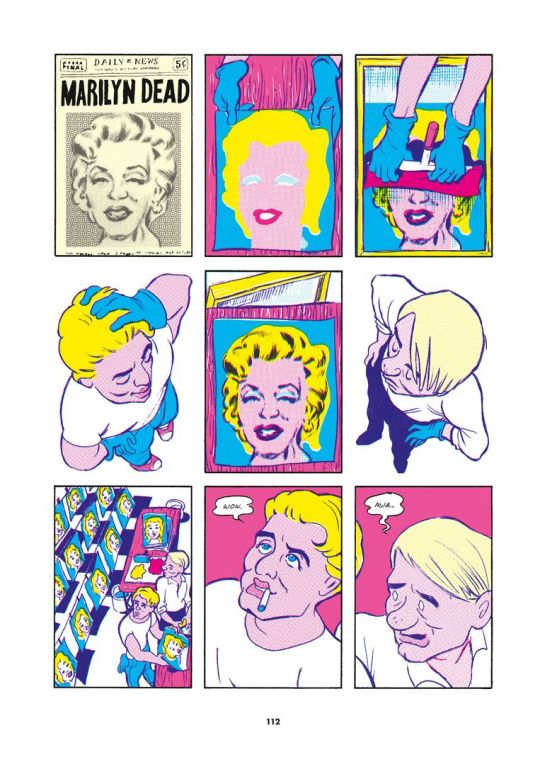
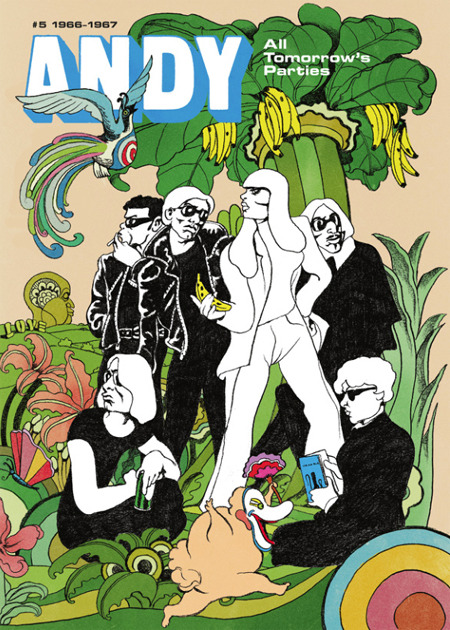
So many icons from the 1930s-1980s have a cameo in this graphic novel it’s just amazing. If you’re even remotely interested in anything of this time period you’d definitely should read this. (seriously, READ THIS). But at this point I’d also like to mention that this comic does not shy away from showing very explicit content and sensetive topics (please keep in mind this has a mature rating for a reason)
Yeah so I couldn’t give this piece of art enough praise. It is absolutely brilliant, a masterpiece in every sense and word.I wasn’t too aware of Typex before but appearentely he also did a graphic novel on Rembrandt. I’m gonna read this too.
Some honorable mentions:
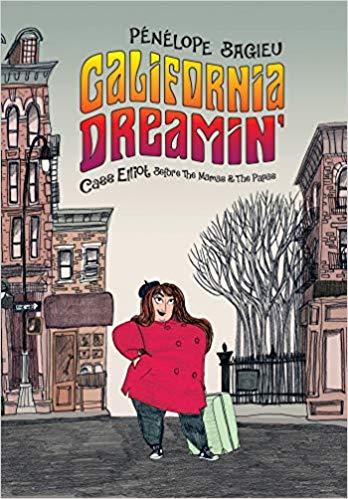
California Dreamin` by Penelope Bagieu
I haven’t red this one yet so I can’t say anything more about it. But I wanted to let you know that a graphic novel about the life of Cass Elliot exists.

Before Watchmen: Silk Spectre by Darwyn Cooke and Amanda Conner
One of the prequels of the legendary “Watchmen” by Alan Moore and Dave Gibbons. It’ “only” an honorable mention because you’ll have to be familiar with the Watchmen universe to fully get all of the story. This prequel focuses on Laurie Jupeczyk, the second Silk Spectre and her own adventures during 1967, the summer of love in San Francisco.
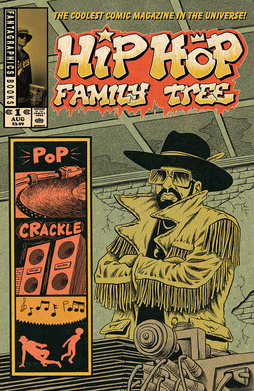
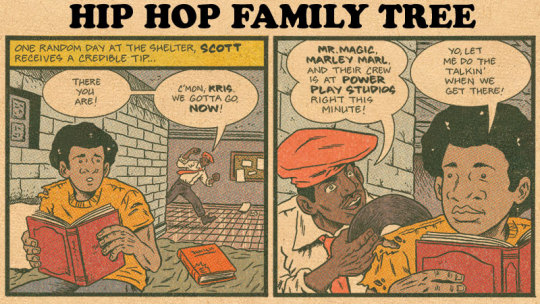
Hip Hop Family Tree by Ed Piskor
Another one I haven’t fully red yet, but so far I’m loving it. It basically tells the history of Rap and Hip Hop from the early 70s to the mid 80s. The art style is intentionally old-school wich really fits it’s tone and setting.
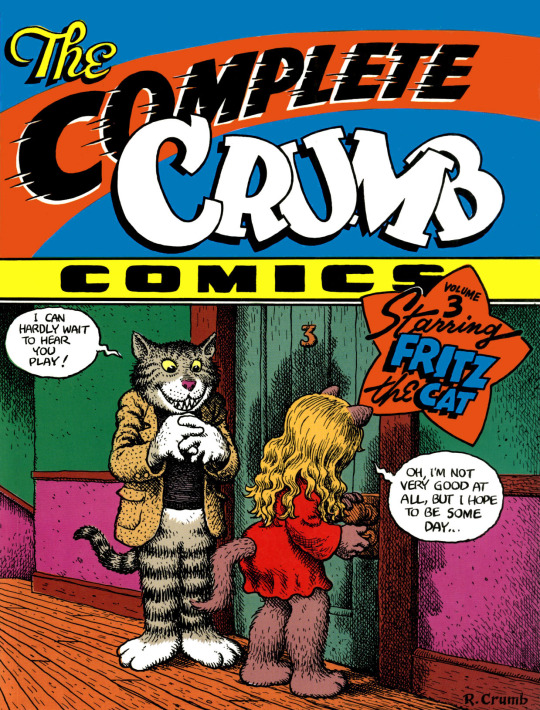
Fritz The Cat by Robert Crumb
I suppose I can’t make a list like this without at least mentioning an absolut icon of the underground comix movement. Crumb created the adventures of this nasty junky cat during the 60s. Fritz can be seen as a satirical mirror of counter-culture’s zeitgeist.
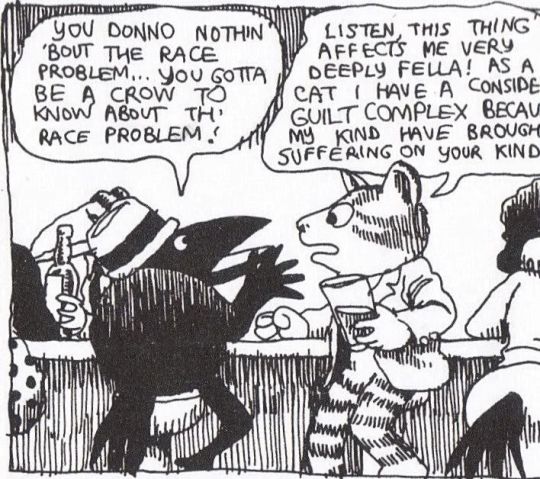
and speaking of Crumb, his “Heroes of Blues, Jazz and Country” trading cards are neat too...

allright that’s it for now. like I said, if you have anymore suggestions, feel free to add ^^
#long post#Cramp talks#classic rock fandom#comic#thierry murat#lorenzo mattotti#nicolas nemiri#francois avril#jean-claude götting#christopher#bezian#dave mckean#alfred#raphaelle le rio#mael le mae#henri meunier#eric stephenson#Nate Bellegarde#jordie bellaire#fonografiks#ed piskor#erik kriek#derf backderf#arne bellstorf#penelope bagieu#mari yamazaki#robert crumb#typex#reinhard kleist#chynna clugston flores
41 notes
·
View notes
Text
Bi-Monthly Reading Round-Up (November/December)
Playlist
“Fallin’ for You” by Sheila Nicholls (The Perilous Gard)
“Come on Over to My Place” by the Drifters (A Gentleman Never Keeps Score)
“Bobby Jean” by Bruce Springsteen (Eleanor and Park)
“Seasons in the Sun” by Terry Jacks (One Perfect Rose)
“A Sailor’s Prayer” by Ann Price and Marilyn Maltzer (Broken Wing)
“Winter Lady” by Leonard Cohen (When a Duchess Says I Do)
“Dance Music” by the Mountain Goats (What Hearts)*
“Sweet Talkin’ Guy” by the Chiffons (Jean and Johnny)
“Know Your Onion!” by the Shins (Lost at Sea)
“The Snake and the Bookworm” by Cliff Richard (Tempting the Bride)
“Everybody Loves Me but You” by Brenda Lee (Someone to Remember)
*I also seriously considered both “I’ll Meet You Halfway” by the Partridge Family and “Sports Analogies” from Crazy Ex-Girlfriend. It’s a complex book!
Best of the Bi-Month
The Perilous Gard by Elizabeth Marie Pope (1974): In the late 1550s, grave, awkward Kate Sutton is banished to a remote castle in the east of England. She’s greeted by superstitious locals, shady servants, an often-absent lord, and the lord’s guilt-ridden (and hot) younger brother. Bored and irritated by all the drama, Kate questions the circumstances of the tragedy that haunts the family. I didn’t have high expectations for this book, which I bought primarily for the gorgeous Richard Cuffari illustrations, but I was blown away. Pope creates a sublimely uncanny setting in a surprising way, and Kate is a wonderful protagonist: principled, rational, and compassionate beneath her no-nonsense exterior.
Worst of the Bi-Month
Someone to Remember by Mary Balogh (2019): In her youth, Lady Matilda Westcott rejected Charles Sawyer’s proposal at the urging of her parents, who thought him too wild. Now she’s fifty-six, loved by her extended family but stuck caring for an unappreciative elderly mother. The marriage of her niece and Charles’s estranged illegitimate son brings them together again, but she never expects anything to come of it...like a total fool. This is a cute novella with compelling family dynamics. I also appreciated the solidly middle-aged protagonists, although Balogh presents them a little too timidly, like a mom trying to get a picky eight-year-old to try asparagus.
Rest of the Bi-Month
A Gentleman Never Keeps Score by Cat Sebastian (2018): Once-popular Hartley Sedgwick is languishing in the huge townhouse his godfather left him, shunned by nearly everyone for his sexuality. Then Sam Fox, a black pugilist-turned-tavern-keeper, tries to sneak into the house to find a nude portrait of an embarrassed friend. Moved by Sam’s decency, Hartley offers his assistance in finding the portrait. As I explained in my post about my favorite Regency romance novels, I adore this book for the way Hartley and Sam’s love story is mirrored and enhanced by portrayals of many other kinds of love, between brothers and friends and parents and children and neighbors and also one very homely dog.
Eleanor and Park by Rainbow Rowell (2012): Park, a geeky half-Korean teenager in 1986, keeps his head down and barley avoids outright ostracism in his poor, mostly white Omaha neighborhood. Eleanor, the weird white girl who shares his bus seat, is tormented at school and at home. They have no interest in being friends, but they slowly bond and fall in love over music and comics. What I liked most about this bittersweet YA novel was the ways in which the protagonists improved each other’s lives. With Park and his loving family, Eleanor gets to let down her defenses, while Eleanor’s boldness inspires Park to embrace his differences. I do wish that Park’s side of things had been developed more, however.
One Perfect Rose by Mary Jo Putney (1997): Upon learning that he’s terminally ill, Stephen, the Duke of Ashburton, freaks out and goes on an incognito tour of the English countryside without telling his family. He ends up joining an acting troupe run by the boisterous Fitzgerald family and falling in love with their adopted daughter/stage manager, Rosalind, despite the many reasons they have no future together. (Or do they?) This is a good, old-fashioned weepy romance that’s elevated by Putney’s serious attention to the theme of reconciling with one’s mortality. There’s also some extremely late-1990s New-Age-ish stuff going on, which sometimes felt a little silly but was still charming.
Broken Wing by Judith James (2008): When unconventional countess Sarah finds her long-lost little brother at a Parisian brothel, she’s overjoyed, appalled, and relieved that he was protected by sex worker Gabriel St. Croix. Grateful, she offers Gabriel a reward and insists he come to live with her and her family. This is another tear-jerking, charmingly dated romance; I felt like a teenager again, reading top-shelf angsty fanfiction. It’s best in the slow-burn first half, during which Gabriel must adjust to a massive reversal of fortune after a lifetime of trauma. The more action-packed second half makes great use of the unusual late 1790s/early 1800s setting, but it does feel hurried.
When a Duchess Says I Do by Grace Burrowes (2019): Widowed Matilda Wakefield, the Duchess of Bosendorf, has been on the run since getting mixed up in her diplomat dad’s clandestine activities. An encounter with scholarly Duncan Wentworth lands her a live-in secretarial position at his rural estate. They connect with each other, but how can love grow when they’re the object of multiple sinister plots? While this entry in the Wentworth series is not as incandescently lovely as My One and Only Duke, I’m still a sucker for spooky country houses, responsible-household-management plots, and sad early-middle-aged heroes. Burrowes is also an excellent writer, and I’m glad that I discovered her.
What Hearts by Bruce Brooks (1992): Sensitive Asa excels at school but struggles at home, thanks to his mother’s severe mental illness and his stepfather Dave’s emotional abuse. Divided into four novella-like sections, the novel follows Asa from his parents’ divorce in first grade to his first love in seventh. I liked parts of this weird, sober book when I read it as a kid, and I felt the same this time. It’s got brilliant moments, most involving Asa and Dave’s relationship, but there’s a lot of telling-not-showing in between. Brooks also can’t seem to decide on the time period; it’s probably supposed to be set 1965-1971, but it always feels like 1963, and you can only blame so much of that on the North Carolina setting.
Jean and Johnny by Beverly Cleary (1959): Short, bespectacled, and working-class, fifteen-year-old Jean feels invisible at her high school until handsome upperclassman Johnny Chessler starts paying attention to her. She’s thrilled, but her parents and sister warn against chasing him. I didn’t like this book much in middle school, but I revisited it because it occurred to me that Jean was a lesbian. Having reread it, I know I was wrong on two counts: Jean is unfortunately not a lesbian (she clearly thinks Johnny’s hot), and the book’s not that depressing. Jean’s no sad sack who’s doomed to a life of grimly chaste square dancing; she’s a legit snack who becomes increasingly self-assured and assertive.
Lost at Sea by Bryan Lee O’Malley (2003): Raleigh, a Canadian eighteen-year-old, hitches a ride back home from California with some classmates she hardly knows after a meeting with her long-distance boyfriend ends in heartbreak. Lonely and a little disconnected from reality--she maintains the belief that her mom somehow sold her soul, which now resides in a stray cat--Raleigh slowly makes friends with her travelling companions and finds some piece of mind. Although nothing much happens in this short graphic novel, it’s one of the most authentically just-graduated-high-school stories I’ve ever read. I could relate to those feelings of fear and disappointment even in the face of exciting new possibilities.
Tempting the Bride by Sherry Thomas (2012): David Hillsborough, Lord Hastings, has desired Helena Fitzhugh, first-wave feminist and successful fiction editor, since they were kids together, but he’s always hidden behind insulting remarks. When Helena’s affair with a married man ends in scandal, though, she unhappily accepts David’s offer of marriage in order to cover it up. Then she gets hit by a carriage and loses every memory she formed after her mid-teens, which happens to be when she met David. Thomas always has an engaging style and deals with even outlandish plots in a sophisticated way, and her take on the 13 Going on 30 plot is enjoyable. However, it is rushed at the end.
2 notes
·
View notes